Updated on March 13, 2025 by Angelika
Are you ready to discover Germany's magnificent landscapes? This comprehensive guide takes you to the 52 most beautiful areas of our country with countless excursion destinations worth seeing. Breathtaking mountain peaks, pristine forests and crystal-clear lakes are just waiting to be explored by you. Each region offers unique nature experiences - and if you're in the mood for urban flair, the nearest big city is never far away.
So lace up your hiking boots, pack your binoculars and discover areas you may never have heard of. Let's explore the unforgettable panoramas and tranquil retreats between the rugged East Frisian coast and the natural spectacles of Berchtesgadener Land together and reorganize your bucket list.
This guide is not intended to be read from A to Z. Use the table of contents or the overview map as a guide and jump to the region you are interested in by clicking on the paragraph title in the table of contents.
The 52 most beautiful regions in Germany at a glance
The North
Embark on a journey of discovery through the north of Germany, which welcomes visitors with an impressive mix of dramatic coastlines, mysterious forests and glittering lake landscapes. From the stormy beaches of the North Sea to the tranquil waters of the Mecklenburg Lake District and the historic landscapes of Brandenburg, the north is rich in natural wonders and cultural heritage. Here you can stroll through the lively Hanseatic cities with their maritime history or enjoy the secluded tranquillity of the charming Baltic and East Frisian islands. The north is a paradise for anyone who loves the water and wants to experience culture and history up close.
1. East Frisia: Between Marshland and the Wadden Sea
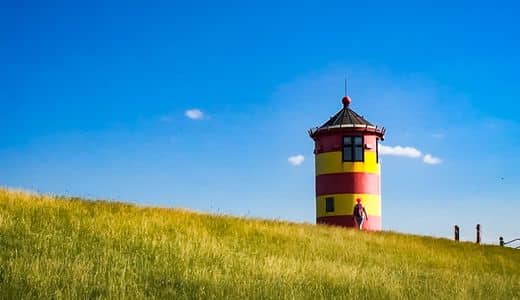
East Frisia is located in the far northwest of Germany and is known for its vast marshlands and the fascinating Wadden Sea. The unique culture, which is characterized by a deeply rooted seafaring tradition, rugged nature, windmills and East Frisian tea, makes East Frisia a very special travel destination.
Highlights:
- Wadden Sea: The UNESCO World Heritage Wadden Sea, offers an extraordinary natural landscape that can be explored on foot or on guided mudflat hikes can be explored. The tidal landscape is an important habitat for numerous bird species and marine life.
- Moorland landscapes: The mystical moorland areas of East Frisia, such as the Ewiges Meer, the largest upland moor lake in Germany, offer unique hiking opportunities and are an important part of the ecosystem.
- East Frisian tea culture: : In 2016, the East Frisian Teetied (Low German for "tea time") by the German UNESCO Commission in the national list of intangible cultural heritage. East Frisian tea is served with Kluntje (rock candy) and cream. In many towns and villages in East Frisia there are pretty tea rooms where you can order a delicious piece of cake or an apple strudel to go with your traditional tea.
Places of interest:
- Emden: The seaport of Emden is the cultural heart of East Frisia with a magnificent Renaissance town hall and the renowned Kunsthalle Emden, founded by former Stern publisher Henri Nannen, who, like Emden's second greatest son Otto Waalkes, was born in Emden. You can find out all about Otto and his work in Dat Otto Huus. The Ostfriesisches Landesmuseum, which sheds light on the geographical and cultural history of the region and includes a fantastic view from the tower, provides more in-depth knowledge.
- Greetsiel: This picturesque fishing village offers beautiful photo opportunities and invites you to linger, from historic captain's houses to the charming harbor of the Krabbenfischerwunderbare and two historic windmills. On the dyke just outside Greetsiel stands the Pilsum lighthouse - Known from the movie "Otto - Der Außerfriesische", it has become a trademark of East Frisia and is well worth a visit.
- Leer: This charming harbor town, also known as the "Gateway to East Frisia", offers a fascinating mix of maritime history and modern flair. The historic old town with its picturesque alleyways, richly decorated half-timbered houses and picturesque harbor invite you to explore. Also worth seeing are the Leer Miniature Land and Bunting Tea Museumwhich presents the tea culture of East Frisia in detail.
Tips for your trip:
- Best time to travel: In summer, the days are long and ideal for extensive exploration, while fall and spring are particularly attractive for nature lovers when migratory birds visit the Wadden Sea. I personally wouldn't recommend winter because of the often gray and damp weather, although there are holidaymakers who love this time of year when they have the coast almost to themselves.
- Events: Visit local festivals such as the Emden Matjestage or the Greetsiel Weekwhich offer deep insights into regional culture and gastronomy.
- Nature conservation: When visiting the Wadden Sea, you should be aware that it is an important nature reserve. Respect nature and follow the instructions of the guides on mudflat walks.
East Frisia combines culture and nature in a unique way. The region not only offers the impressive experience of the Wadden Sea, but also deep insights into maritime culture and history. Whether at a tea ceremony, hiking through the moorlands or exploring historic towns and villages, East Frisia promises an enriching experience for every visitor.
Continue reading
I have put together my tips for The Most Beautiful Cities in Germany for you in a separate article.
If you feel like going on a road trip in Germany while browsing through this article, you can find inspiration for beautiful routes in my article Road Trip Germany - The Most Beautiful Routes with Highlights and Map.
A list of over 100 great travel destinations in Germany - sorted by federal state - for an initial overview can be found in the article Destination Germany - The Ultimate List of the 100+ Most Beautiful Places.
2. The East Frisian Islands in Focus: Natural Beauty, Sea Breeze and Island Idyll

This chain of seven inhabited islands off the East Frisian North Sea coast offers a unique mix of pristine beaches, dune landscapes and ancient seafaring culture. Each island has its own character, from the lively seaside resorts of Norderney and Borkum to the tranquil nature reserves of Spiekeroog and Langeoog. The islands belong to the UNESCO World Heritage Wadden Sea,which you can explore on guided mudflat walks.
Highlights:
- Beach and sea: Kilometers of sandy beaches invite you to sunbathe, walk and swim, while the North Sea is a paradise for water sports enthusiasts.
- Bicycle tours through the dunes: Explore the islands on two wheels and discover hidden corners and fantastic views. Bicycles can be hired on all islands.
- Seal watching: The sandy shores are a popular resting place for harbor seals and grey seals, especially in spring and fall when the pups are born.
- Lighthouses: Each island has at least one historic lighthouse, which not only serves as a landmark, but also offers fascinating insights into the region's navigational history.
Places of interest:
- As one of the larger East Frisian islands, Norderney offers an attractive mix of nature experience and urban flair. With its well-known Thalasso Center, which offers wellness treatments with a marine theme, and many cafés, restaurants and boutiques on the beach promenade, Norderney is ideal for those seeking relaxation as well as those who like to be active.
- Wangerooge: This car-free island is known for its tranquillity and closeness to nature. Wangerooge is a paradise for birdwatchers - here you have exceptional opportunities to see rare bird species. The annual Friesenwoodstock Music festival attracts fans of open-air concerts who like to enjoy music in a relaxed beach atmosphere.
- Juist: Often referred to as "the magical island", Juist is the perfect place to immerse yourself in tranquillity. With a length of 17 kilometers, it offers one of the longest sandy beaches of the East Frisian Islands. The car-free island is particularly known for its sustainable tourism, with a strong focus on nature conservation and environmental protection.
Tips for your trip:
- Best time to travel: The islands can be visited all year round, but spring and summer are ideal for beach vacations, while autumn is particularly suitable for nature watching.
- Getting around: Bicycles are the preferred means of transportation on most of the islands. Some islands are car-free, which contributes to the quiet and relaxed atmosphere.
- Note the tides: As the islands are strongly influenced by the tides, it is important to take ebb and flow times into account when doing activities by the sea.
The East Frisian Islands offer a perfect escape from everyday life and are a dream destination for nature lovers and those seeking relaxation. Here you can enjoy the tranquillity of nature, immerse yourself in the history of seafaring or simply unwind on the beach.
3. Teufelsmoor: A Refuge for Art and Nature
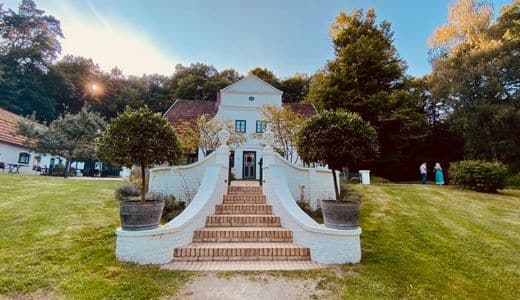
Teufelsmoor, one of the most fascinating moorland landscapes in northern Germany, lies to the north-east of Bremen. This region is not only known for its unique ecological conditions, but also for its inspiring effect on artists and writers. The moor offers a mystical landscape characterized by tranquillity and originality.
Highlights :
- The artists' village of Worpswede: Worpswede has served as a retreat for artists since the end of the 19th century and is the cultural heart of the Teufelsmoor. Visit the numerous galleries, studios and museums dedicated to the art of Worpswede painters such as Heinrich Vogeler, Otto Modersohn and Paula Modersohn-Becker.
- Hiking and cycling in Teufelsmoor and Hammeniederung : The region offers unique flora and fauna that you can discover on walks, hikes and bike tours. There are also highly recommended Guided moorland hikes. You can also go on beautiful bike tours in the region.
- A traditional Peat barge trip: on the waterways of the moor is a special experience and offers a unique perspective of the landscape.
Places of interest:
- Birdwatching in the Teufelsmoor and the Hammen lowlands: The region is known for its rich birdlife and offers ideal conditions for birdwatching. Specially constructed observation towers and hides allow nature lovers to observe rare and protected bird species such as cranes, marsh harriers and various water birds in their natural habitat without disturbing them. You can take a 40 km bike tour along the individual stations. Don't forget to bring binoculars!
- Barkenhoff: Barkenhoff in Worpswede, once the home of the famous artist Heinrich Vogeler, is now an important museum offering insights into the life and work of the Worpswede artists' colony. The carefully restored complex with its striking green roof and beautifully landscaped garden embodies Vogeler's artistic and utopian vision and serves as a venue for exhibitions that explore the cultural heritage and artistic significance of the region. The poet Rainer Maria Rilke spent a lot of time at the Barkenhoff between 1898 and 1902, but lived with Clara Westhoff in neighboring Westerwede.
- Haus im Schluh: This historic ensemble of buildings was once Martha Vogeler,'s home, who set up a new house here with her three daughters after her separation from Heinrich Vogeler. Today it is a museum dedicated to the applied arts in Heinrich Vogeler's work and the artists who lived in the house.
Tips for your trip:
- Best time to travel: The Teufelsmoor is worth a visit at any time of year, with each season having its own charms. In spring and summer, nature is in full bloom, while in autumn the heath landscapes glow in bright colors.
- Cultural events: In addition to the regular art exhibitions and workshops, Worpswede hosts annual events such as the "Open Air Gallery", the Rose Festival at the Barkenhoff and open studios.
- Photographing in the early morning light: Experience the special atmosphere of the Teufelsmoor by grabbing your camera early in the morning and capturing the rising sun over the moorland.
You like this post and want to get the latest updates? Then subscribe to my newsletter!
4. Heligoland: Nature Experiences, Cliffs and Deep-Sea Bunkers
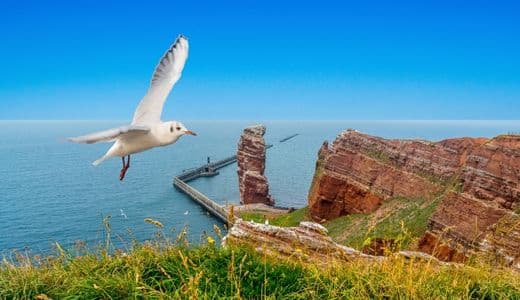
Heligoland, which is only about 4 km2 the only rocky island in the North Sea, is a popular day trip destination for coastal residents and tourists. Red sandstone and the brightly painted lobster shacks - former fishermen's workshops - set colorful accents. In winter, the grey seal nursery on the dune and in summer the breeding birds on the guillemot rock offer unique nature experiences.
Highlights:
- Guillemot rock: The famous bird cliff is the breeding ground of the largest guillemot colony in Europe. In spring and early summer, visitors can experience the impressive natural spectacle of the birds breeding at close quarters.
- Heligoland dune: The dune ferry takes you to the Helgoland dune, where you can observe Germany's largest predator, the grey seal, in its natural environment. Grey seals are only on land during whelping season (December) and when they change their fur (March). If you want to observe pups, you have to go to Heligoland in winter, as the seals give birth to their young in December.
- Oberland: The Oberland offers spectacular views of the surrounding North Sea and the lower town. Accessible by elevator or via the serpentine path, it is a must for every visitor to Heligoland.
Places of interest:
- Lange Anna - The island's landmark: Lange Anna, an imposing rock needle made of red sandstone, rises out of the sea like a gigantic spike and is the symbol of Heligoland. The surrounding cliffs offer spectacular views of the island and the sea.
- Heligoland lobster shacks: The charming lobster shacks on the harbor invite you to stroll and shop. Here you will find local specialties, handicrafts and maritime souvenirs.
- Bunker tunnels and civil defense bunker: On April 18, 1945, British bombers destroyed the island. Many islanders survived the attack 18 meters below ground in the 14 km long underground tunnel system. The exhibition in the bunker tunnel in the Unterland can be visited on your own (ideal for day visitors), while the civil defense bunker in the Oberland can only be visited as part of a one-hour guided tour of the bunker.
Tips for your trip:
- Best time to travel: Late spring and early summer are particularly attractive for birdwatchers. A unique nature experience is the Lummensprung from mid-June to the end of July, when the young birds jump from the cliffs and are led out onto the open North Sea by their fathers. Silke Hartmann, the birdwatcher, has written a blog article worth reading about the Birds on Heligoland written. Another highlight is the grey seal moult in March and April. Pack binoculars for wildlife spotting!
- Enjoy Heligoland crabs: Taste the freshly caught Heligoland crabs in the island's cozy restaurants and fish stalls.
- Arrival: Heligoland can be reached by ferry or plane. Note that the island is car-free, which contributes to the quiet and relaxed atmosphere.
- Sunset on the north beach: Don't miss the breathtaking sunset on Nordstrand, a magical moment to end the day.
Heligoland offers a breathtaking combination of nature experiences, cultural events and historical sights. Its unique location and diverse flora and fauna make it an ideal destination for anyone who wants to get away from it all and experience something very special.
5. Experience Sylt: Coastal Magic and Savoir Vivre
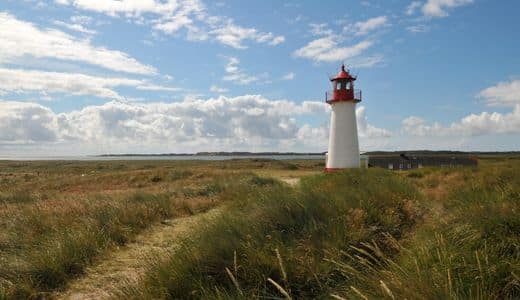
Sylt is not just an island, but a way of life. The combination of impressive nature and elegant flair makes Sylt a place of longing for travelers. Whether relaxing hours on the beach, cultural discoveries or culinary delights - everyone will find their own personal island paradise on Sylt.
Highlights:
- Rotes Kliff and Kampen - natural spectacle and jet-set charm: The Red Cliff between Wenningstedt and Kampen is particularly spectacular when the setting sun turns the 30-metre-high clay gravel wall a deep red. Kampen itself is known for its jet-set atmosphere, stylish accommodation and first-class restaurants. This is where the rich and famous meet!
- Westerland: The island's capital, Westerland, delights visitors with its elegant shopping streets, first-class restaurants and lively atmosphere.
- Beach and coastal experiences: Explore the island on a bike tour along the picturesque coastal paths or relax in one of the exclusive wellness hotels in the Sylt dunes and experience relaxing hours with a sea view.
Places of interest:
- Keitum - historical charm and island romance: This picturesque town with its thatched Frisian houses, manicured gardens and cobbled streets was the main town on Sylt and home to many captains until the mid-19th century. Stroll through the charming alleyways, visit small galleries and stop off at one of the cozy cafés. The Old Frisian House provides an insight into the living culture of the 18th century and informs visitors about the history of the village.
- List - natural beauty in the north: The northernmost town on the island, List, impresses with its unique dune landscape and picturesque harbor. The Ellenbogen (Ellbow) on the north-eastern tip of the island (which elongs to List) and the whole of Germany, is a natural paradise with untouched dunes, an impressive view of the Wadden Sea and lots of sheep.
- Braderuper Heide nature reserve: A beautiful heathland area that is one of the most beautiful nature experiences on Sylt and offers excellent birdwatching opportunities. Walk along picturesque wooden paths and steps through the sea of flowers. As there are three different types of heather in Braderup Heath, which bloom in different months (crowberry from the end of April, bell heather from July, broom heather from the end of August), you have a good chance of experiencing a heather blossom during your stay.
Tips for your trip:
- Best time to travel: Sylt is an attractive destination all year round, with the summer months being particularly popular for beach vacations and the quieter spring and autumn months ideal for nature watching.
- Pure enjoyment in the beach bistros: Sample local delicacies and fish specialties in the cosy beach bistros while admiring the sunset over the North Sea.
- Events: The Craft Beer & Gourmet Festival, the Kampen Literary Summer and the Windsurfing World Cup are just some of the many events that characterize the island's cultural life.
Sylt is an island of contrasts, offering both peace and relaxation in nature and a lively social scene. Whether walking along the dunes, cycling through idyllic villages or enjoying fresh seafood - Sylt offers something for everyone and will definitely leave a lasting impression.
6. Altes Land (the "Old Country"): Between Orchards and Hanseatic Cities
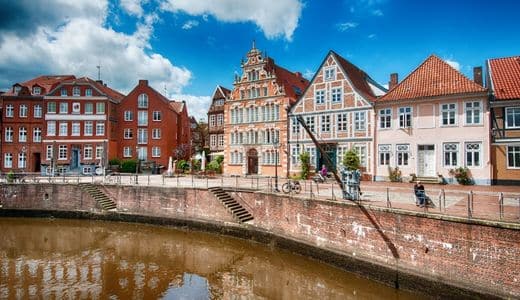
The Alte Land between Hamburg and Stade is the most enchanting of all the Elbe marshes and Germany's largest fruit-growing region. This rural area on the outskirts of the city is ideal for dyke hikes along the Elbe and moorland rivers.
Highlights:
- Orchards as far as the eye can see: The Alte Land is famous for its orchards, especially for apples and cherries. In spring, the trees turn into a sea of blossoms, in autumn they glow in warm colors. If you are here in spring, you should not miss the most famous festival in the Altes Land, the Altländer Blossom Festival. It takes place annually on the first full weekend in May.
- Old half-timbered houses: The region is dotted with traditional half-timbered houses that tell their own story. Crossed gabled swans often adorn the beautiful old farmhouses with their characteristic half-timbered walls.
- Elbe ferry to Hamburg: A short crossing of the Elbe takes you to Hamburg. This gives you a taste of the big city air before you dive back into the tranquil atmosphere of the Altes Land. Also read my paragraph about Hamburg in the blog post The Most Beautiful Cities in Germany.
Places of interest:
- Jork: Jork is often referred to as the "heart of the Altes Land" and is the central venue for the Altländer Blütenfest. The town is known for its beautiful half-timbered houses and St. Matthias Church, which impresses with its baroque altar.
- Stade: This historic Hanseatic city is the perfect starting point for your voyage of discovery in the Altes Land region. Stroll through the charming old town, whose moats and ramparts date back to the Swedish era (1648 - 1712), visit the Schwedenspeicher Museum and enjoy North German cuisine in the local fish restaurants.
- Fruit farm tours: Numerous fruit farms open their doors to visitors. Here you can not only pick fresh fruit, but also learn more about fruit growing.
Tips for your trip:
- Best time to travel: Spring, when cherry and apple blossoms transform the Alte Land into a sea of white and pink flowers, is the most beautiful time, but it is also the busiest. Autumn is a busy but also atmospheric time: during the apple weeks, the cideries produce fresh apple juice and cider, the shelves in the farm stores are full to bursting with apples, and the smell of fresh apple pie wafts from the bakeries and cafés.
- Activities: In addition to the fruit farm tours, you can go on extensive bike tours along the Elbe river or enjoy nature on the numerous hiking trails.
- Events: The Altländer Blütenfest in May is a cultural highlight that you shouldn't miss. Enjoy the festive atmosphere with parades, music and the crowning of the Blossom Queen.
The Altes Land is perfect for a relaxing and restful vacation. Here you can unwind, enjoy nature and experience the history and culture of the region. The city of Hamburg, which can be reached quickly by Elbe ferry, provides cultural variety.
7. Lüneburg Heath: Between Heather Blossom and Half-Timbered Houses
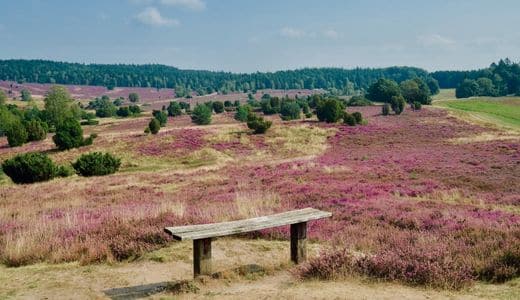
The Lüneburg Heath enchants visitors with its extensive cultural landscape of heather fields, moors and deciduous forests as well as its picturesque towns and villages. Especially during the heather blossom in August and September, when the heather transforms the landscape into a purple carpet of flowers, the region shows its most beautiful side.
Highlights:
- Heather blossom: The breathtaking natural spectacle of the heather blossom is undoubtedly the highlight of a visit to the Lüneburg Heath. In late summer, the landscape is transformed into a sea of purple and violet colors. The best places to experience this spectacle are the Südheide Nature Park and the Lüneburg Heath Nature Reserve.
- Hiking and cycling: The Heath is a paradise for nature lovers and active vacationers. Numerous hiking and cycling trails criss-cross the region and offer the perfect opportunity to explore unspoiled nature.
- Heather Blossom Festival (Heideblütenfest) and Heath Queen: A cultural highlight in Amelinghausen that celebrates the flowering season with concerts, dances and an open-air laser show, including the election of the Heath Queen.
Places of interest:
- Wilseder Berg: At 169 m, this picturesque hill is the highest point in the North German Plain. From here you have the best panoramic view of the blooming heathland in late summer.
- Nature reserves: Lüneburg Heath is surrounded by numerous nature reserves where rare plants and animals are protected. Here you can experience untouched nature in all its glory.
- Historic cities: With Lüneburg and Celle, the Lüneburg Heath is home to two of the most charming towns in northern Germany. The medieval Hanseatic city of Lüneburg is one of the main centers of North German brick architecture. Here you can marvel at many beautiful late Gothic and Renaissance buildings in medieval Lüneburg. The old ducal town of Celle is known for its enchanting closed town center, its magnificent Renaissance castle and the Hanoverian warmbloods of the Lower Saxony State Stud. Horse lovers get their money's worth at the world-famous stallion parades at the end of September/beginning of October.
Tips for your trip:
- Best time to travel: May to September, with the main attraction being the heather blossom in August and September.
- Special events: Plan your visit around the Heideblütenfest to experience this regional highlight.
- Exploration tips: Use guided tours or explore the heath independently on foot or by bike. Remember to wear suitable footwear and sun protection.
The Lüneburg Heath is a perfect destination to escape the hustle and bustle of everyday life, enjoy nature and explore the old half-timbered towns of Celle and Lüneburg. The historic towns are beautiful destinations at any time of year, but you can only experience the spectacular play of colors of the heather blossom in late summer.
8. The Bay of Lübeck: Cultural Highlights and Idyllic Beaches
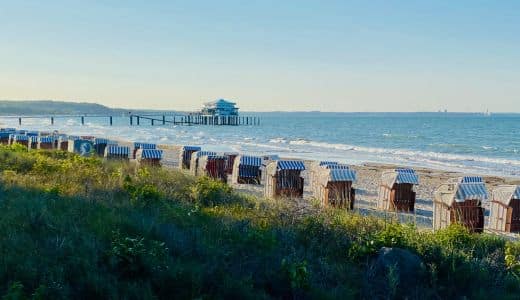
It is a relic of the division of Germany that the western part of this bay on the German Baltic Sea coast is known as the Bay of Lübeck and the eastern part as the Bay of Mecklenburg. The Bay of Lübeck on the Baltic coast of Schleswig-Holstein attracts visitors from all over the world with its wide sandy beaches, its charming to sophisticated seaside resorts, and its cultural highlights. The coastline offers a perfect mix of relaxation by the sea and cultural discoveries, embedded in a landscape that invites you to linger and enjoy.
Highlights:
- Beach promenades from Scharbeutz to Travemünde: Stroll along the lively promenades, enjoy local specialties in the numerous cafés and restaurants or simply relax on the beach and watch the hustle and bustle.
- Lübeck: : The nearby Hanseatic city of Lübeck, known as the "city of seven towers" and UNESCO World Heritage Site.The city attracts visitors with its impressive medieval architecture and famous marzipan delicacies. Lübeck is one of the most beautiful cities in Germany and should definitely be on your bucket list.
- Brodten Cliffs: The 4-kilometre-long windswept cliff between Travemünde and Niendorf offers magnificent views of the Baltic Sea and is still an insider tip. Most of the Brodten shore is a nature reserve - among other things, one of the largest sand martin colonies in Europe can be found here. A hiking and cycling trail runs above the cliffs.
- Fehmarn: The island of Fehmarn, often referred to as the "sunshine island", is an Eldorado for sun worshippers and water sports enthusiasts with over 2,200 hours of sunshine per year. Visit the island's capital Burg with its beautiful old town and the lively port of Burgstaaken, explore the Fehmarn Marine Center with one of the largest shark pools in Europe or the almost 300 m2 Wallnau waterfowl reserve with nature trail and experimental stations.
Places of interest:
- Old lighthouse Travemünde: This historic lighthouse not only offers maritime flair, but also a museum that introduces visitors to the region's maritime history.
- Timmendorfer Strand pier: A landmark of the region, ideal for relaxing walks with a view of the Baltic Sea. Take a leisurely stroll along the beach promenade to Niendorf harbor, where you can enjoy a rustic dinner at one of the fish stalls or dine in a fine restaurant, depending on your taste and budget.
- Eutin: Often referred to as the "Weimar of the North", Eutin is a beautiful destination with its historic castle and picturesque castle park. An integral part of the musical program at the Eutin Festival is "Der Freischütz" by Eutin's most famous son, Carl Maria von Weber.
- Neustadt in Holstein: For those interested in history, a visit to this pretty little town is well worthwhile. The worst catastrophe in the Bay of Lübeck occurred off Neustadt on May 3, 1945 - five days before the surrender of the German Wehrmacht - when the ships Cap Arcona, Thielbek and Germany with thousands of concentration camp prisoners on board were bombed and sunk by the Royal Air Force.
Tips for your trip:
- Best time to travel: The best time to visit the Bay of Lübeck is during the summer months, when the region attracts visitors with sunshine and warm temperatures, ideal for beach and water activities as well as cultural explorations.
- Events: From classical concerts at the Eutin Festival to regatta sailing at the Travemünde Week, the region offers numerous cultural and sporting events.
- Culinary delights: Enjoy fresh fish and regional specialties in the numerous restaurants along the coast and in the historic city centers. Extra Tip: The marzipan nut cake from the Niederegger café in Lübeck is a treat you shouldn't miss if you have a sweet tooth like me.
- Excursion to Wismar: : Within an hour from Timmendorfer Strand you can reach the UNESCO World Heritage City of Wismar in Mecklenburg-Vorpommern. If you love brick Gothic and medieval towns, you will love this beautiful Hanseatic city on the Baltic Sea.
- Excursion to Schwerin: Schwerin, the state capital of Mecklenburg-Western Pomerania, is also within easy reach and its magnificent Residence ensemble was inscribed on the UNESCO World Heritage List in 2024.
The Bay of Lübeck is the perfect destination for anyone looking for a combination of culture and relaxing days by the sea. Whether exploring towns steeped in history or enjoying the beach - everyone will be happy in this beautiful corner of Germany.
9. Between Sky and Sea: The Vorpommersche Boddenlandschaft
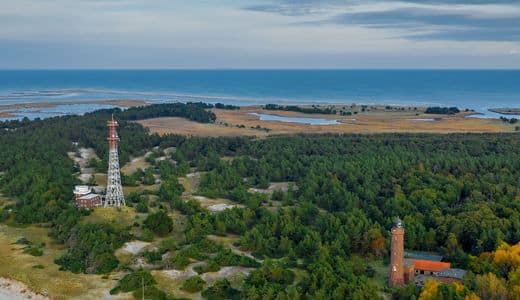
A unique combination of untouched nature, picturesque coasts and rich flora and fauna awaits you in the Western Pomeranian Bodden landscape. The typical waters of this region - the so-called "Bodden" - are shallow bays that are the habitat of numerous bird species and seal populations.
Highlights:
- Western Pomerania Lagoon National Park (Nationalpark Vorpommersche Boddenlandschaft): This national park is a paradise for nature lovers and offers a unique landscape of open bodden areas, reed belts, extensive forest areas and untouched beaches. Especially during the crane migration in spring and fall, this place becomes a spectacular observation point.
- Hike through the Darßwald forest to the west beach: A walk through the unspoiled Darßwald forest, which leads to the pristine western beach, is a must. This part of the Darß peninsula shows the wild beauty of nature, with wind-sculpted trees and one of the most beautiful beaches in Germany.
- Sailing and kayaking tours:Take advantage of the unique waterways of the Bodden for extended sailing or kayaking tours that guarantee an unforgettable experience in the natural beauty of the region.
Places of interest:
- Zingst: The idyllic Baltic seaside resort of Zingst attracts visitors with its charming alleyways, quaint fishermen's cottages and lively harbor atmosphere. Here you can enjoy fresh fish and the maritime atmosphere.
- Island of Hiddensee: The car-free island of Hiddensee is the perfect place to take a deep breath in the middle of the Bodden landscape. With its pristine beaches, the Dornbusch lighthouse and the picturesque village of Kloster, it invites you to slow down and enjoy the tranquil atmosphere.
- Hanseatic City of Stralsund: The nearby Hanseatic city of Stralsund offers exciting cultural insights with its historic old town, which is a UNESCO World Heritage Site, and the Maritime Museum.
Tips for your trip:
- Best time to travel: The weather is most stable for outdoor activities between June and September. Amateur ornithologists come in September/October when thousands of cranes come to rest.
- Animal observations: Between mid-March and early April and from September to the end of October, you can observe the migration and resting of the cranes. Up to 70,000 birds then gather in the shallow lagoons of the national park. The fallow deer can be observed during the rutting season from September to early October, especially in the east of Zingst. Remember to bring your binoculars !
- Events: Visit local festivals such as the Darß Marathon or the Crane Festival, which celebrate the nature and culture of the region.
The Vorpommersche Boddenlandschaft offers you everything you could hope for from a natural paradise. Here you can experience the Baltic Sea off the beaten tourist track and actively relax or simply enjoy the tranquillity of nature.
10. Island of Rügen with Jasmund National Park: Chalk Cliffs and Spa Architecture

Rügen, Germany's largest island, lies in the Baltic Sea and is known for its breathtaking chalk cliffs, extensive sandy beaches and historic seaside resorts. The island attracts visitors from all over the world with its diverse landscape, which ranges from beech forests to picturesque fishing villages and sophisticated seaside resorts.
Highlights:
- Chalk cliffs in Jasmund National Park: The impressive white cliffs in Jasmund National Park are Rügen's landmark and became world-famous thanks to Caspar David Friedrich's painting. Since 2011, the Jasmund National Park to UNESCO World Heritage Site.. Stroll through the beech forest and admire the contrasting landscape of chalk cliffs, forest and Baltic Sea.
- Rasender Roland (Raging Roland): Climb aboard this historic steam train from the 19th century and explore the island in a nostalgic way. The route takes you through idyllic landscapes and past charming villages.
- Störtebeker Festival: Every year from mid-June to the end of August, Rügen resurrects the pirate Klaus Störtebeker at the famous open-air plays on the Ralswiek natural stage. Exciting adventures, spectacular stunts and impressive special effects promise an entertaining evening.
Places of interest:
- Binz and Sellin: These elegant Baltic seaside resorts are famous for their spa town architecture, piers and wide sandy beaches that invite you to sunbathe and take a stroll. Here you will find numerous restaurants, cafés and boutiques where you can while away the day.
- Cape Arkona: Visit the spectacular cliffs in the very north of the island, where two lighthouses rise up. Here you can experience the elemental force of the Baltic Sea!
- Granitz hunting lodge: Granitz Hunting Lodge is located in the middle of the Southeast Rügen Biosphere Reserve and is the most visited castle in Mecklenburg-Vorpommern. From the central tower, you have a magnificent view across the island to the Bay of Binz.
- Prora: The gigantic, unfinished Nazi building was intended to accommodate 20,000 holidaymakers and is certainly one of the most bizarre buildings in the whole of Germany. In the documentation center, you can find out more about the eventful history of the monumental building, which now houses a youth hostel, vacation apartments and luxury condominiums following extensive renovation work.
Tips for your trip:
- Best time to travel: Rügen is an attractive destination all year round. The summer months are ideal for beach vacations, while spring and autumn, with fewer visitors and mild weather, are perfect for hiking and exploring nature.
- Getting around: The island is perfect for exploring by bike. Many places are connected by excellent cycle paths that lead through scenic areas. Alternatively, public transport is a good way to discover every corner of the island.
- Events: In addition to the Störtebeker Festival, the Sand Sculpture Festival in Prora and the Blue Wave Festival in Binz also attract visitors with music and culture.
The island of Rügen has something for everyone: breathtaking nature, fascinating culture and relaxing wellness offers. Enjoy the many possibilities and experience unforgettable moments on Germany's largest island!
11. Mecklenburg Lake District: A Natural Paradise in the Heart of Germany
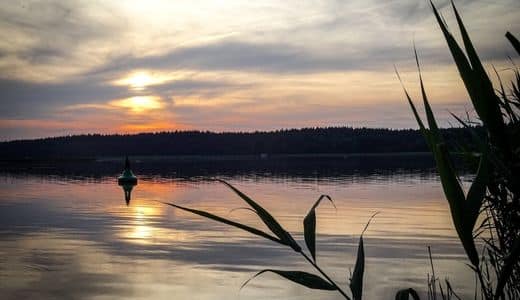
The Mecklenburg Lake District, the largest contiguous lake landscape in Central Europe, offers countless opportunities for water sports enthusiasts, nature watchers and those seeking relaxation. With over a thousand lakes connected by rivers and canals, this region is a dream destination for anyone who loves water and wants to enjoy nature in its original form.
Highlights:
- Waterways: The Mecklenburg Lake District is a paradise for water sports enthusiasts. Whether at sailing, paddling or swimming - the clear, clean waters are ideal for a variety of activities. The numerous lakes are connected by rivers and canals, making them perfect for extensive boat tours makes. Perhaps a Vacation on a houseboat something for you?
- Müritz National Park: This national park encompasses the Müritz, Germany's second largest lake (after Lake Constance), and a variety of smaller bodies of water and forests. It is home to a wealth of wildlife, including white-tailed eagles, otters and cranes, and offers excellent opportunities for wildlife spotting and hiking. The viewing opportunities during the crane migration in spring and fall are particularly impressive. The sub-area Serrahn is part of the UNESCO World Heritage Site Ancient and Primeval Beech Forests of the Carpathians and Other Regions of Europe.
- Stargazing: There is a lot of forest and water in the Mecklenburg Lake District, and therefore relatively few sources of light. Especially if you are traveling by houseboat, you should make yourself comfortable on deck after dark and keep an eye out for the Milky Way - you will hardly be able to see it more clearly in any other region of Germany than here!
Places of interest:
- Schwerin: The state capital on Lake Schwerin - the second largest in Mecklenburg-Western Pomerania - impresses with its historic old town and fairytale castle, which is picturesquely situated on an island in Lake Schwerin. The "Neuschwanstein of the North" also forms the picturesque backdrop for the annual open-air festival.
- Güstrow: The historic town of Güstrow enchants visitors with its imposing Güstrow Castle, a masterpiece of Renaissance architecture. The castle, surrounded by a magnificent garden, is now home to a museum that brings the history of the region and the art of the Renaissance to life.
- Neustrelitz: This Baroque residential city on Lake Zierk is the gateway to the Mecklenburg small lakes. The baroque garden laid out in the 18th century was transformed into a landscape park in the 19th century. However, the castle belonging to it was destroyed during the Second World War. The Slavic village Neustrelitz takes you back 1000 years to the time when Mecklenburg-Western Pomerania was populated by Slavic tribes.
- Müritzeum in Waren (Müritz): This modern nature experience center offers exciting insights into the flora and fauna of the Mecklenburg Lake District. The highlight of Germany's largest aquarium for native freshwater fish is the two-storey vendace tank.
Tips for your trip:
- Best time to travel: The Lake District is particularly attractive from spring to fall, when nature awakens, the temperatures are pleasant and most leisure activities are possible.
- Getting around: Many of the lakes and attractions are best accessed from the water, so it is worth hiring a boat or taking part in a guided boat tour.
- Bring your binoculars for animal and stargazing!
The Mecklenburg Lake District is an Eldorado for nature lovers and active vacationers. The unique landscape of water and forest invites you to relax, explore and enjoy and makes every visit an unforgettable experience.
12. Elbtalaue: Floodplain Landscape on the Former Inner-German Border
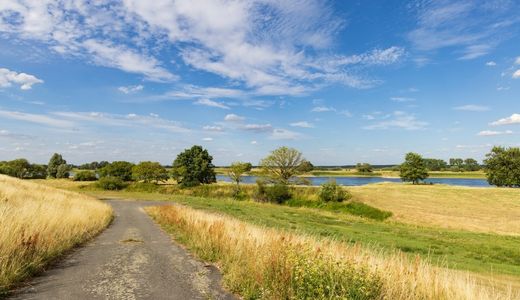
The Brandenburg Elbe floodplain with the Biosphärenreservat Flusslandschaft Elbe-Brandenburg (Elbe-Brandenburg River Landscape Biosphere Reserve): is an idyllic river landscape with extensive alluvial forests, species-rich wetlands and the gently flowing Elbe. It is an ideal destination for nature lovers, ornithologists and those seeking relaxation. Until reunification, part of the inner-German border ran along the Elbe - the restricted zone was an important refuge for many rare animal and plant species.
Highlights:
- Biosphärenreservat Flusslandschaft Elbe-Brandenburg (Elbe-Brandenburg River Landscape Biosphere Reserve): A UNESCO biosphere reserve characterized by its rich biodiversity and unspoiled nature. Visitors can observe rare animal species such as the stork, the beaver and various water birds in their natural habitat in the floodplains.
- River trips and canoe tours: Explore the Elbe floodplain actively by boat or canoe and discover the hidden beauties of the river landscape.
- Cycling on the Elbe cycle path: This popular cycle path leads along the Elbe and offers wonderful views as well as numerous rest stops in the picturesque villages along the way.
- Stork village Rühstädt: Visit the village of Rühstädt, which is known for its high density of stork pairs and has been awarded the title of European Stork Village.
Places of interest:
- Nikolaikirche Pritzwalk: The Gothic brick church with its neo-Gothic tower houses a remarkable winged altar and an altar suite designed by Karl Friedrich Schinkel.
- Perleberg: The charming old town of Perleberg impresses with its well-preserved half-timbered houses, the historic town hall and the town and regional museum, which offers insights into the history and culture of the region.
- Bad Wilsnack: With the St. Nikolai Church of the Miraculous Blood Bad Wilsnack attracts pilgrims and cultural travelers. In the Kristall Therme spa, you can relax in saunas, steam baths and saltwater pools.
- Plattenburg Castle: Plattenburg Castle is one of the oldest and best-preserved moated castles in northern Germany. It offers a fascinating backdrop for cultural events and an insight into medieval castle life.
Tips for your trip:
- Best time to travel: The Elbe valley floodplain is at its most beautiful from May to September, when the floodplain landscape is in full bloom and the wildlife is at its most active. In spring and early summer, you can also observe the many pairs of storks that nest in the region.
- Bike tours: Take advantage of the well-developed network of cycle paths, which are ideal for exploring the extensive floodplain landscape of the Elbe valley. There are several routes along the Elbe that lead through picturesque villages and past historical sights.
- Birdwatching: Pack your binoculars - the Elbe-Brandenburg River Landscape Biosphere Reserve offers excellent birdwatching opportunities. For example, the Rambow moor is used as a roost by around 4,000 cranes in spring and late fall. The arrival of the cranes shortly before sunset is an impressive experience.
The Brandenburg Elbe floodplain is a retreat for anyone looking for peace and quiet in nature while exploring one of the most beautiful river landscapes in Germany, and also boasts some interesting historical sights.
13. The Havelland: A Picturesque River Landscape Near Berlin
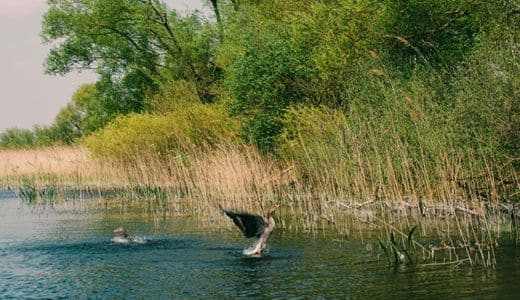
Theodor Fontane dedicated an entire volume of his series "Walks through the Mark Brandenburg" to the Havelland and also summed up the beauty of the region: "Landmarks, castles, palaces and cathedrals are reflected in your river". The section between Potsdam and Brandenburg an der Havel is particularly attractive, where the river widens into the elongated Havel lakes. The most famous of these is Schwielowsee, where Albert Einstein spent his last years in Germany in Caputh before he immigrated to the USA in 1933 after the Nazis seized power.
Characterized by the Havel lakes, extensive orchards and picturesque villages, Havelland is an idyllic retreat for those seeking relaxation, culture enthusiasts and nature lovers.
Highlights:
- A boat tour on the Havel: Explore the branching waterways of Havelland by boat and discover hidden bays, historic locks and sprawling river landscapes.
- Cycling along the Havelland cycle path: The well-maintained cycle path leads through the characteristic landscape of Havelland, past orchards, through nature reserves and along the banks of the Havel.
- Westhavelland Nature and Star Park: In Germany's first "Dark Sky Reserve" - an area with minimal air pollution - you can stargaze like nowhere else in Germany at specially equipped observation points. Night walks are also offered.
Places of interest:
- Ribbeck Castle: Ribbeck Castle in Nauen, famous from Theodor Fontane's poem "Herr von Ribbeck auf Ribbeck im Havelland", is now home to a museum dedicated to the history of the region and the von Ribbeck family. The café in the old wash house in the village serves what is said to be the best pear cake in Havelland.
- Brandenburg an der Havel: Discover the historic old town, St. Peter and Paul Cathedral, the magnificent neo-Gothic town hall and the picturesque riverside promenades of the city, which is considered the cradle of the Mark Brandenburg. Don't be surprised by the bronze woodland monkeys you see everywhere - they are reminiscent of Vicco von Bülow, alias Loriot, who was born in Brandenburg an der Havel.
- The Havelland painters' colony in Ferch: The Museum of the Havelland Painters' Colony in Ferch commemorates 19th century artists who settled in Ferch and on Lake Schwielowsee, inspired by the Märkisch landscape.
- Optikpark Rathenow: In Rathenow, the "city of optics", the park offers a beautifully designed garden landscape that invites you to stroll and linger.
Tips for your trip:
- Best time to travel: Havelland is attractive at any time of year. Springtime, with its magnificent flowers, and autumn, with its colorful deciduous forests, are particularly recommended for visits.
- Animal observations: Look out for the numerous stork nests that can be found in the villages of Havelland in spring and summer. You can also spot sea eagles, ospreys, kingfishers and sand martins. Beavers and otters also feel at home in the water-rich floodplain landscape. Bring your binoculars!
- Events: The annual Havelland Music Festival offers music lovers a wide range of concerts in historic buildings and outdoors.
Havelland enchants its visitors with a harmonious blend of culture, history and nature, just a stone's throw from the capital city of Berlin. It has something for everyone and is an ideal destination for day trips or longer stays.
14. Schorfheide with Grumsin Beech Forest: Natural Heritage in Northern Brandenburg
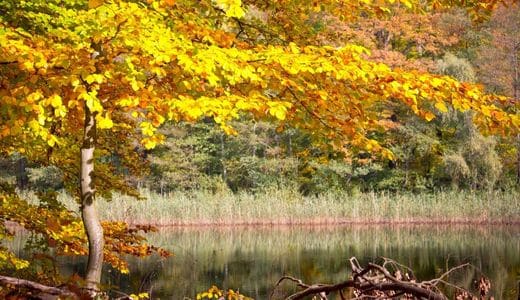
The Schorfheide formed by the last ice age, is a fascinating natural landscape to the north-east of Berlin. In the Grumsin beech forest which has been a UNESCO World Heritage Site since 2011. Ancient and Primeval Beech Forests of the Carpathians and Other Regions of Europe you can experience a piece of primeval forest in the middle of Germany.
This vast area is a mosaic of ancient beech forests, clear lakes, vast heathlands and marshy moors, providing a unique habitat for a variety of animal and plant species. It is a refuge for nature lovers, hikers and anyone who wants to immerse themselves in the tranquillity and beauty of pristine nature.
Highlights:
- Animal observations in the Schorfheide-Chorin biosphere reserve: The biosphere reserve is home to rare animal species such as the otter, the white-tailed eagle and the black stork. Special observation points and guided tours offer the opportunity to experience this fascinating wildlife in its natural habitat.
- Hikes through the Grumsin beech forest: The Grumsin Beech Forest, part of the UNESCO World Heritage Site Ancient Beech Forests and Primeval Beech Forests of the Carpathians and other regions of Europe, captivates visitors with its majestic, centuries-old beech trees, which guarantee an impressive experience of nature. Explore the marked trails and immerse yourself in the tranquillity of this pristine forest landscape.
- Exploratory tours through the Schorfheide: The Schorfheide offers an extensive network of hiking and cycling trails that lead through a landscape of breathtaking diversity - from dense forests and open heathland to glistening lakes.
- Water fun: The many lakes in the region, such as Werbellinsee, Grimnitzsee and Weiße See, are perfect for swimming in summer. With sunbathing lawns - some with playgrounds and kiosks - quiet bathing spots and natural bathing beaches, everyone will find the right spot for them. Sailors and surfers are drawn to the Werbellinsee.
Places of interest:
- Chorin monastery ruins: The most important brick Gothic building in the Mark Brandenburg is beautifully situated near Lake Parstein. In summer, the famous Chorin Summer of Music to enjoy a concert in a historic setting.
- Schorfheide Wildlife Park: At Groß Schönebeck, visitors can experience native wild animals such as red deer, wolves and mouflons up close in spacious enclosures.
- Werbellinsee, Grimnitzsee and Weißer See: The clear, deep Werbellinsee is not only a paradise for water sports enthusiasts, but also offers beautiful lakeside promenades for relaxing walks. Grimnitzsee and Weiße See lakes invite you to swim in summer with their sunbathing lawns - some of which have playgrounds and kiosks -, quiet bathing spots and natural bathing beaches.
Tips for your trip:
- Best time to travel: When the forests show themselves in fresh green in spring or in autumn spectacular colors, is the most beautiful time for the Schorfheide and the beech forest. In the Summer the numerous lakes offer almost unlimited water fun.
- Don't forget a binoculars to observe the diverse birdlife in the area.
- The Information point UNESCO World Natural Heritage Beech Forest Grumsin offers an exhibition on the World Heritage Site and is a good starting point for hikes.
The Schorfheide and the Grumsin beech forest offer a unique combination of protected nature, cultural heritage and diverse recreational opportunities. Just outside the capital city of Berlin, one of the largest contiguous forest areas in Central Europe invites you to experience nature in a variety of ways.
15. Fläming: A Picturesque Hilly Landscape Southwest of Berlin
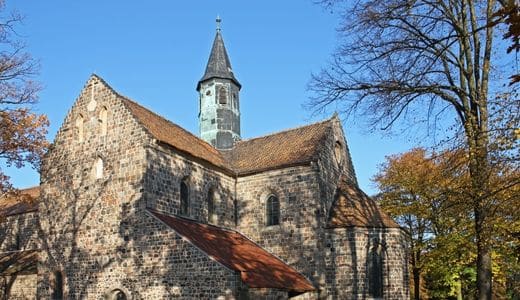
The Fläming, a glacial mountain range up to 200 m high, stretches north from Wittenberg to the south-western city limits of Berlin, and the idyllic region is accordingly popular as a quickly accessible destination for a short break for stressed city dwellers. The region was named after the Flemish settlers who were brought into the country after the Mark Brandenburg was founded in 1157. In the picturesque villages, farmers offer their produce in their farm stores.
Highlights:
- Hiking on the Flaeming Skate: The Fläming-Skate, an extensive network of specially designed smooth paths, is not only a paradise for inline skaters, but also ideal for cyclists and hikers who want to explore the scenic diversity of the Fläming. You will find many beautiful hiking trails in the Fläming here.
- Explore the castles and palaces: The Fläming region is home to a number of impressive historical buildings, including the Wiesenburg Castle, the Rabenstein Castle and Eisenhard Castlet in Bad Belzig, which offer a deep insight into the history of the region.
- Relaxation in the SteinTherme spa in Bad Belzig: The thermal baths with their healing brine water offer relaxation for body and soul in six pools - one of which is outdoors.
Places of interest:
- The Hoher Fläming Nature Park: One of the largest nature reserves in Brandenburg with its extensive forests, clear streams and historic mills invites you to go on long hikes and experience nature.
- Zinna Monastery: The monastery church of St. Maria of the former Cistercian monastery near Jüterbog is an architectural jewel from the 12th century. In addition to the monastery complex, concerts such as the Zinna Monastery Summer Music Kloser attracts culture enthusiasts between June and the beginning of September.
- Lutherstadt Wittenberg: Situated on the edge of the Fläming, the UNESCO World Heritage City of Wittenberg world-famous as the starting point of the Reformation. Visitors can discover the castle church with the famous Thesis Door, the Luther House and numerous other historical sites closely associated with the life and work of Martin Luther. Lucas Cranach the Elder also lived in Wittenberg for 40 years and left behind numerous traces - in the Cranach Courtyards and the Cranach House, where he had his painting studio and ran his print shop, you can follow in the footsteps of this important artist of the Reformation era.
Tips for your trip:
- Best time to travel: The best time to visit the Fläming is spring and autumn, when nature is ablaze with vibrant colors and the temperatures are ideal for outdoor activities.
- Try the farm stores and restaurants regional specialtiessuch as the Fläminger roast venison or the Zerbst pear.
- Combine a relaxing stay in the Fläming with excursions to the UNESCO World Heritage Sites in Dessau (Bauhaus sites and Garden Kingdom of Dessau-Wörlitz), which are only a stone's throw away.
- Reisechronistin and slow traveler Tina shows many videos with insider tips about the Fläming on her YouTube channel.
The Fläming offers a harmonious blend of nature, culture and history. With its rolling hills, historical sights and the opportunity for active recreation, the region attracts visitors who are looking for something special. Whether hiking through the nature park, exploring medieval castles or relaxing in thermal springs - the Fläming leaves unforgettable impressions.
The Center
A fascinating mix of historic towns, lush forests and fertile landscapes awaits you in the middle of Germany. Ancient trade routes intersect here, and every town and village has its own story to tell. Experience the diversity of this region: from the dense beech forests of the Hainich National Park, to the romantic river valleys of the Rhine and Moselle, to the cultural treasures in cities such as Trier, Weimar and Dresden. Here you will find an extensive cultural heritage embedded in landscapes that invite you to hike, cycle and explore. The center of the country offers a cross-section of German history and nature, ideal for anyone who wants to get to know as many facets of Germany as possible.
16. Teutoburg Forest: A Green Ribbon through North Rhine-Westphalia

The Teutoburg Forest stretches right across North Rhine-Westphalia to Lower Saxony and is particularly famous for the Varus Battle in the year 9 AD, in which the Germanic tribes under the Cheruscan prince Arminius (Hermann) defeated the Roman legions - German readers will certainly know the date from their history lessons.
The dense forest landscape, rolling hills, moorland, brine and springs make the Teutoburg Forest a popular destination for hikers, cyclists and health-conscious people.
Highlights:
- Hermannsweg: One of the most beautiful high-altitude hiking trails in Germany runs for 156 kilometers along the ridge of the Teutoburg Forest from Rheine to Horn-Bad Meinberg. It runs through a varied landscape of rustic mixed forests, rugged cliffs and wide valleys, offers spectacular views and passes through places worth seeing such as Tecklenburg, Warburg and Bad Iburg.
- Externsteine: This striking sandstone rock formation of 13 steeply rising rocks near Horn-Bad Meinberg has fascinated people for centuries and is still considered a mystical place by many today. Every year, half a million people visit the cult site on the night of July 21 to celebrate the solstice.
- Wellness and meditation: Bad Salzuflen is known for its healing salt pans and thermal baths. The spa park and the imposing spa architecture of the old town offer peace and relaxation in picturesque surroundings. Bad Meinberg is home to Europe's largest yoga ashram, the Yoga Vidya.
Places of interest:
- Hermannsdenkmal: The monumental Hermann Monument near Detmold rises majestically above the Teutoburg Forest and is one of the region's most important landmarks. The monument honors the Cheruscan prince Arminius and his victory over the Roman legions in the Varus Battle. With a figure height of 27 m and a total height of 53 m, the Hermannsdenkmal is the tallest statue in Germany. The view of the Teutoburg Forest from the monument's visitor platform is simply breathtaking. In the Kalkriese Museum and Park in the Osnabrücker Land region, you can find out about the latest research on the Varus Battle.
- Detmold: The historic town of Detmold impresses with its charming town center, the imposing Residential Palace and the LWL Open-Air Museum, the largest open-air museum in Germany and one of the largest in Europe, which presents the rural architecture and way of life of Westphalia.
- Bad Iburg: Picturesquely situated on the southern slope of the Teutoburg Forest, Bad Iburg is known for its historic castle from the 11th century, the town's landmark and former residence of the bishops. Another highlight is the Treetop Walk, which offers breathtaking views of the surrounding nature and the castle.
Tips for your trip:
- Best time to travel: The Spring and autumn are particularly attractive times of the year for a visit, when nature is in full bloom or shows itself in bright colors.
- Use the well signposted Hiking and cycling trails to discover the diverse landscape and cultural treasures of the Teutoburg Forest.
- Regional cuisine and local products, such as the Westphalian ham complement the experience and invite you to enjoy.
The Teutoburg Forest offers a perfect combination of natural beauty, historical sites and recreational opportunities. From mystical natural monuments to legendary battlefields and healing thermal springs - this diverse region promises unforgettable experiences and deep insights into German history and culture.
17. Sauerland: From Rothaarsteig to the Winter Sports Arena
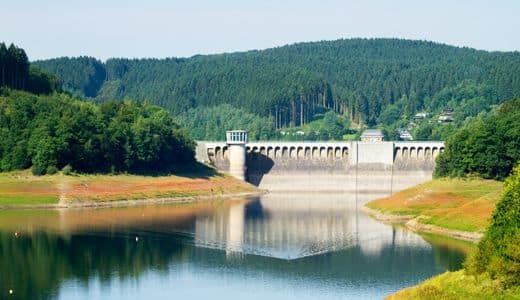
The Sauerland, often referred to as the "land of a thousand mountains", stretches across parts of North Rhine-Westphalia and Hesse. With its dense forests, clear lakes, picturesque valleys and charming villages, the Sauerland offers the perfect backdrop for outdoor activities of all kinds, from hiking and cycling to winter sports and water sports.
Highlights:
- Hiking on the Rothaarsteig: The Rothaarsteig, known as the "Path of the Senses", is one of the 14 Top Trails of Germany. The 154-kilometer trail runs along the ridge of the Rothaargebirge mountains and offers spectacular views, natural experiences and cultural discoveries.
- Hiking and winter sports in Winterberg: Winterberg is the center of winter sports in the Sauerland with numerous ski slopes, cross-country ski trails and the annual highlight, the World Cup in bobsleigh and skeleton sports. The Kahle Asten, NRW's second highest mountain, offers hiking trails for all seasons and levels of difficulty with fantastic views.
- Biggesee and Listersee: The reservoirs offer ideal conditions for relaxing days on the water, and for water sports such as sailing, windsurfing and canoeing.
Places of interest:
- The Atta Cave in Attendorn: One of the largest and most beautiful stalactite caves in Germany, the Atta Cave impresses with its stalagmites and stalagtites up to four meters long in colorful grottos.
- Altena Castle: The medieval Altena Castle, begun in the 12th century, lies high above the town of Altena and is not only worth seeing for its history and architecture. The world's first youth hostel was opened here in 1912.
- Arnsberg: Arnsberg's medieval old town with picturesque half-timbered houses and narrow alleyways is dominated by the ruins of the electoral castle. On the eastern edge of the Arnsberg Forest the forest capital Warstein attracts visitors not only with nature experiences, but also with the Warsteiner World, the visitor center of the famous brewery.
- Fort Fun Abenteuerland: This leisure park in the Sauerland offers fun and entertainment for the whole family with a variety of attractions, shows and activities in a beautiful natural setting.
Tips for your trip:
- Best time to travel: The region is all year round attractive, whereby spring and autumn are particularly attractive for hikers and cyclists, while the winter attracts winter sports enthusiasts.
- Use the SauerlandCard for free or discounted admission to many sights and free use of local public transport in the region.
- Also try the local specialties such as Potthucke (the meaty, Westphalian answer to the tortilla) and pumpernickel (a dark brown, heavy bread), which is part of every snack in the Sauerland.
With its forests, lakes, hiking trails and diverse leisure activities, the Sauerland is the ideal destination for those seeking relaxation as well as for active vacationers.
18. Waldecker Land: Primeval Forest and Sunken Villages in the Heart of Germany
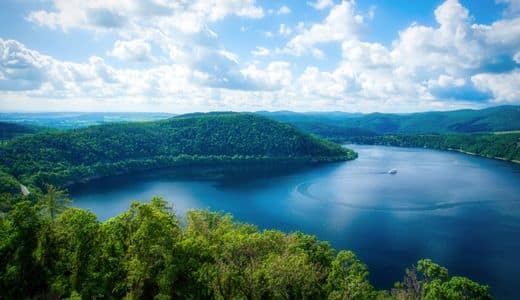
The Waldecker Land region in northern Hesse is rich in natural beauty, historical treasures and cultural highlights. With the foothills of the Rothaargebirge mountains, the Kellerwald forest and Lake Edersee, it offers a picturesque landscape that invites you to go hiking, water sports and exploring. Everyone will find their own adventure in the region's deep forests, rolling hills and clear waters.
Highlights:
- Hikes through the beech forests: The Kellerwald-Edersee National Park is home to one of the last untouched beech forests in Central Europe. Part of the national park is a UNESCO World Heritage Site Ancient and Primeval Beech Forests of the Carpathians and Other Regions of Europe. On one or more stages of the Urwaldsteig (primeval forest trail) which runs for over 60 kilometers around the Edersee, you can discover the primeval forest, the Edersee and the rural cultural landscape at your own pace.
- The Edersee: As one of the largest reservoirs in Germany, Lake Edersee is a paradise for water sports enthusiasts and nature lovers. The Treetop walk Edersee provides insights into the ecosystem of the Kellerwald forest and offers an incomparable view over the national park and Lake Edersee. The Dam wall itself is an impressive structure that is colorfully illuminated by 39 LED spotlights in the evening after dark. When the lake was created over 100 years ago, three villages had to be demolished for the construction of the Eder dam and rebuilt elsewhere above the lake. The remains of the former villages emerge from the Edersee like Atlantis at low tide.
- Guided national park tours: The national park is a refuge for many rare animal species. With a bit of luck, you can observe red deer, wild cats, lynx and a variety of bird species in their natural habitat - the most promising way to do this is on a guided tour with a ranger who knows the best places to visit in the national park, knows a lot about the animals and has all sorts of anecdotes to tell.
Places of interest:
- Waldeck Castle: The landmark of the Waldecker Land region, which now houses a hotel, towers high above Lake Edersee. From here, you have a spectacular view over the lake and the surrounding nature. The castle museum also tells the history of the region.
- WildtierPark Edersee: The WildtierPark offers the opportunity to see native wild animal species such as wolves, lynx and wild boar up close. Complemented by a griffin observatory with flight demonstrations by small and large griffins against the picturesque backdrop of Waldeck Castle, it is an exciting excursion destination for the whole family.
- Bad Wildungen: The charming spa town is known for its healing mineral and thermal springs. The elegant spa promenade, surrounded by magnificent parks and historic buildings, invites you to stroll and relax. Perched high above the half-timbered old town Friedrichstein Castle. Its museum houses a collection of Hessian military history, militaria from the Ottoman Empire and several palace rooms with precious Empire-style furniture.
- Fritzlar: The cathedral and imperial town of Fritzlar is an insider tip on the German Half-Timbered Road! The imposing St. Peter's Cathedral, which dominates the townscape with its striking towers, is an outstanding example of Romanesque architecture. The medieval town center, with its many buildings, is surrounded by an almost completely preserved town wall.
Tips for your trip:
- Best time to travel: Spring to fall, when nature is at its best and you can take advantage of the wide range of leisure activities on offer.
- Excursion tip: Not far from Waldecker Land lies the UNESCO World Heritage Site. Wilhelmshöhe Park near Kassel that you shouldn't miss out on. Highlights of the park include Hercules with its famous cascades and water features, Löwenburg Castle, Wilhelmshöhe Palace and the extensive park itself. You can spend a wonderful day here.
- Take advantage of the guided tours and workshops on offer to learn more about the unique flora and fauna as well as the conservation measures of the Kellerwald-Edersee National Park.
Whether you are looking for relaxation by the water, cultural treasures or active nature experiences - the Waldecker Land region will delight you with its diversity and has something to suit every taste.
19. Westerwald: Discover the Green Heart between the Rhine, Sieg and Lahn Rivers
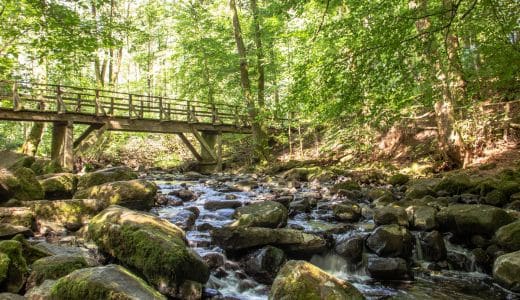
The Westerwald is an idyllic low mountain range landscape between the metropolitan regions of Frankfurt and Cologne. This natural paradise between the Rhine, Sieg and Lahn rivers, with its extensive forests, rolling hills and clear lakes, offers relaxing retreats and a variety of outdoor activities for hikers, cyclists and nature lovers.
Highlights:
- Hikes on the Westerwaldsteig: The Westerwaldsteig, one of Germany's top long-distance hiking trails, leads over 235 kilometers through the Westerwald's picturesque landscape. The route offers magnificent views, cultural sights and leads through characteristic Westerwald villages.
- Fuchskaute: At 657 meters, the highest elevation in the Westerwald attracts hikers and nature lovers with its sweeping views over the hills and valleys of the Westerwald. There are numerous hiking trails around the Fuchskaute, including the Rothaarsteig and the Westerwaldsteig, which lead through the picturesque landscape and tranquil forests to other natural sights and viewpoints.
- Dreifelder Weiher: The Dreifelder Weiher is the largest lake in the Westerwald lake district and offers excellent opportunities for fishing, swimming and water sports. The surrounding hiking and cycling trails invite you to explore the nature around the waters.
- Kannenbäckerland: The Westerwald is known for its high-quality ceramics. One center of the pottery trade is Höhr-Grenzenhausen, where the Ceramics Museum Westerwald presents historical and contemporary ceramics.
Places of interest:
- Montabaur: Montabaur's landmark is the striking yellow castle on a hill above the town, which combines baroque architecture with modern elements and now serves as a hotel and conference center. The castle park and the historic old town with its well-preserved half-timbered gabled houses are also worth a visit.
- Marienstatt Abbey: This historic Cistercian monastery is picturesquely situated on the River Nister and attracts visitors with its Gothic church, peaceful monastery grounds and popular brewery.
- Basaltpark in Bad Marienberg: This geopark shows the geological diversity of the Westerwald, in particular the basalt columns that are typical of the region. Hiking trails lead through the park and explain the Westerwald's volcanic history.
Tips for your trip:
- Best time to travel: The Westerwald is attractive at any time of year. Spring offers blooming landscapes, summer entices with numerous festivals, autumn fascinates with colorful foliage and winter invites you to take romantic walks.
- Regional specialties: Sample the local cuisine, which includes game dishes and the famous Westerwald potato soup, and discover the region's small but excellent craft beer scene.
- Nature experiences: Pack sturdy shoes for hikes. In winter, you can explore the region on cross-country ski trails.
The Westerwald offers a rich history, traditional ceramic art and inviting small towns and is also a perfect destination for anyone looking for peace and relaxation in nature.
20. Eifel Experience: Between Wild Nature and Cultural Heritage
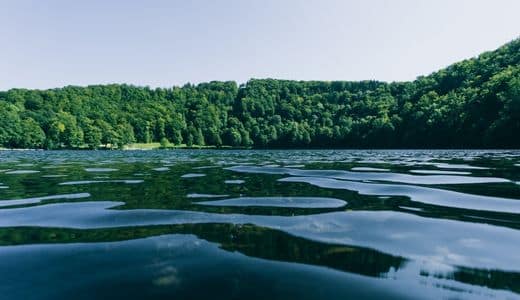
The Eifel, a varied low mountain range in western Germany, stretches across Rhineland-Palatinate and North Rhine-Westphalia and extends as far as Belgium and Luxembourg. The Volcanic Eifel is home to 350 volcanoes, maars, geysers, mineral and carbon dioxide springs. With numerous castles, monasteries and historic towns, there is also plenty to discover for history buffs. The Eifel is an ideal destination for anyone who appreciates the combination of nature and culture.
Highlights:
- Eifel National Park: Experience untouched nature in the Eifel National Park, where beech forests, daffodil meadows and maar lakes combine to form a unique ecosystem. The Wilderness Trail offers you the opportunity to discover the diversity of the landscape on hikes lasting several days.
- Explore volcanic activity: The Volcano Eifel fascinates with its maars, the "eyes of the Eifel", and geological museums such as the Volcano Museum in Daun and the Lava Dome in Mendig, which offer exciting insights into the region's volcanic past.
- Historical sites: Visit the imposing Eltz Castle, one of the best-preserved castles in Germany, or the Maria Laach Monastery with its famous Romanesque basilica on the Lake Laach, the largest lake in Rhineland-Palatinate.
Places of interest:
- Monschau: This picturesque little town, known for its well-preserved old town with half-timbered houses, narrow streets and a castle, offers a charming insight into the culture of the Eifel.
- Bad Münstereifel: This historic spa town with its fully preserved town wall, romantic half-timbered houses and impressive town gate also attracts visitors with its medieval atmosphere.
- Ahr valley: Famous for its red wine, the Ahr Valley enchants visitors with its steep vineyards, idyllic hiking and cycling trails and the medieval wine village of Ahrweiler.
- Geyser Andernach: The world's highest cold-water geyser in Andernach on the Rhine is an impressive natural spectacle and testifies to the volcanic activity still present in the region.
- Rursee: The second largest reservoir in Germany offers numerous leisure activities such as hiking, cycling and water sports in the beautiful surroundings of the Eifel National Park.
Tips for your trip:
- Best time to visit: The Eifel is an attractive destination all year round, with each season having its own charm. In spring and summer, nature comes to life, autumn attracts visitors with its colorful deciduous forests, and in winter the Eifel is transformed into a winter sports region.
- How about a road trip on the German Volcano Road? This themed route takes you through the volcanic history of the Eifel and connects 39 sights over 280 kilometers, including maars, lava caves, museums and geological highlights.
The Eifel is an incredibly diverse vacation region that combines natural wonders and cultural heritage. From the mysterious maars to picturesque villages and historical monuments, it offers countless opportunities for explorers and those seeking relaxation.
21. Upper Middle Rhine Valley: World Heritage Site Full of Romance and History
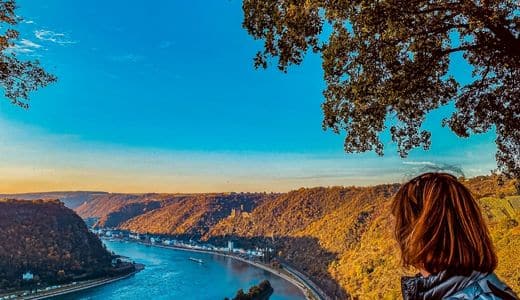
Between dramatic cliffs and steep vineyards, the untamed Rhine meanders through the deeply incised valley of this wildly romantic landscape between Bingen, Rüdesheim and Koblenz. On the heights of the slate mountains on both sides of the Rhine sit around 40 castles, fortresses and fortifications which were built in the Middle Ages and are now mostly just picturesque ruins. The Upper Middle Rhine Valley has been on the UNESCO World Heritage List since 2002 and attracts visitors from all over the world.
Highlights:
- Castles and palaces along the Rhine: The Upper Middle Rhine Valley is famous for its high density of castles and palaces, some well-preserved, some picturesquely ruined. The Rheinstein Castle and Stolzenfels Castle were rebuilt in the course of the Rhine Romanticism according to plans by Karl Friedrich Schinkel and are typical examples of the castle Renaissance of the 19th century. Marksburg Castle above the half-timbered town of Braubach is the only undestroyed hilltop castle on the Middle Rhine.
- Wine tastings and wine walks: The steep vineyards of the Middle Rhine Valley are home to some of the best Rieslings in the world. Numerous wineries, for example in Rüdesheim and Bacharach, offer tastings and guided tours that provide an insight into the tradition of winegrowing in this region.
- The Rheinsteig: This hiking trail runs for around 320 kilometers along the right bank of the Rhine through spectacular landscapes. The magnificent views of the Rhine valley, castles, forests and rugged cliffs make up for the challenging climbs.
Places of interest:
- Rüdesheim: The Drosselgasse in Rüdesheim am Rhein is a narrow lane lined with traditional wine taverns and stores - and probably one of the most famous streets in Germany. It is worth taking the cable car to the Niederwald monument up to the Rüdesheimer Berg (wonderful views!) and take a hike through the vineyards.
- Koblenz: Koblenz marks the northern end of the UNESCO World Heritage Site Upper Middle Rhine Valley. I recommend the cable car ride to the Ehrenbreitenstein Fortress. On the journey and from above you have a magnificent view of the confluence of the Rhine and Moselle at the Deutsches Eck.
- The Loreley: The famous slate rock near St. Goarshausen is not only an impressive natural monument, but also the setting for the legend of the blonde Loreley, who is said to have lured the boatmen on the Rhine to their doom with her singing. The Loreley open-air stage is one of the most beautiful event locations in Germany.
- Bacharach: This picturesque wine village is surrounded by a ring wall from the 16th century with many towers . Rising above the village is the Stahleck Castle which is home to a youth hostel. Bacharach, characterized by wine-growing, many half-timbered houses and medieval walls, is one of the prettiest places in the Upper Middle Rhine Valley.
Tips for your trip:
- Best time to travel: Spring to autumn, when the vineyards are in full splendor and the region celebrates numerous festivals and events. Between May and September, the Rhein in Flammen (Rhine in Flames) with large fireworks displays at various locations on the Rhine is an unforgettable experience. In the September and October the mild autumn light and the foliage coloring bathes the region in pure gold.
- A Boat trip on the Rhine offers you a new and unique perspective on the castle-crowned rocks and steep slopes of the region.
- Regional specialties: Try the famous white wines of the region. A high-proof pleasure is the Rüdesheim Coffee which was invented in 1957 for the Asbach company (a brandy produced in Rüdesheim).
The Upper Middle Rhine Valley impresses with its scenic beauty, romantic castles and palaces and a lively wine-growing tradition. Both nature and culture lovers can spend an enjoyable vacation here.
22. Moselle Valley from Koblenz to Trier: A River Landscape Between Wine and History
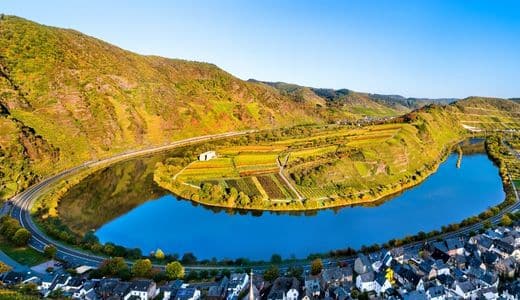
The Moselle valley between Koblenz and Trier is one of the most picturesque and historically interesting landscapes in Germany. Steep vineyards, romantic castles and picturesque villages stretch along the winding course of the Moselle, making this region one of the most beautiful river landscapes in Europe. The Romans brought viticulture to the region. The valley, known for its exquisite Riesling, attracts not only wine lovers, but also culture enthusiasts and nature lovers who want to experience the unique combination of nature, culture and gastronomy.
Highlights:
- Wine tastings and hikes through the vineyards: Discover the world-class wines of the Moselle Valley during a tasting directly at the winegrower or on one of the many wine trails that offer breathtaking views of the river landscape.
- Moselsteig trail and "'Dream Trails": The Moselsteig Trail leads from Perl in the border triangle of Germany, France and Luxembourg through vineyards and to viewpoints along the Moselle to Koblenz. The 365 km are divided into 24 daily stages. The Rhine-Moselle-Eifel region also offers the Dream Trails and Dream Paths on which you can enjoy wonderful views, medieval castles and steep vineyards on circular hikes of varying difficulty.
- Visit the historic cities: Koblenz with its imposing Ehrenbreitstein Fortress and Deutsches Eck (German Corner), as well as Trier, Germany's oldest city and UNESCO World Heritage Site. with Roman monuments such as the Imperial Baths, and Porta Nigra offer deep insights into the history of the region.
- Exploring the Moselle castles: The numerous castles and ruins along the Moselle, such as the Eltz Castle, one of the best-preserved castles in Germany, and the Cochem Imperial Castle offer fascinating insights into medieval life.
Places of interest:
- Bernkastel-Kues: This charming little town is known for its historic market square, surrounded by half-timbered houses, and the ruins of the Landshut Castle which towers above the town and offers a spectacular view over the Moselle valley.
- The Moselle loop near Bremm: It is one of the most famous photo motifs in Germany and a highlight for every visitor to the Moselle valley.
- The Calmont via ferrata: For the more adventurous, the steepest vineyard in Europe, the Calmont near Bremm, offers a via ferrata with challenging paths and incomparable views of the Moselle valley.
- The Geierlay suspension bridge: Although not located directly in the Moselle valley, a detour to the Geierlay, Germany's longest suspension bridge near Mörsdorf in the Hunsrück, is a breathtaking experience for anyone with a head for heights.
Tips for your trip:
- Best time to visit: May/June and September/October are ideal for a visit to the Moselle valley with pleasant temperatures and little rain. At harvest time in autumn, the vineyards shine in all their glory - enjoy the experience of one of the many wine festivals in the decorated villages!
- A bike tour on the Moselle cycle path or a boat trip on the Moselle are ideal ways to enjoy the beautiful river valley at a relaxed pace.
- Take the opportunity to sample regional specialties such as Moselle wine and fried Moselle fish or a vintner's steak in the numerous wineries and restaurants along the river.
The Moselle Valley between Koblenz and Trier is an area that makes every trip unforgettable thanks to its beautiful landscape, its historical significance and its renowned wine tradition.
23. The Palatinate Forest: A Symphony of Rocks, Forests and Vineyards
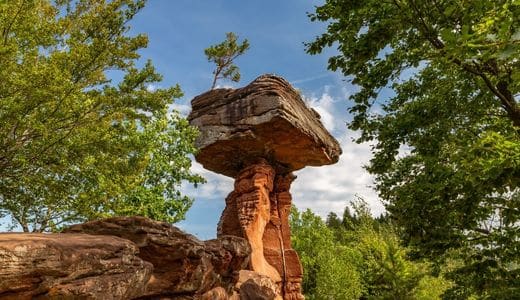
The Palatinate Forest, part of the cross-border Palatinate Forest-North Vosges biosphere reserve, is one of the largest contiguous forest areas in Germany and is located in the heart of the Palatinate. With its rolling hills, deep forests and striking sandstone cliffs, the "Tuscany of Germany" offers an ideal backdrop for hikers, climbers and nature lovers. The rich cultural history, winding wine routes and hospitable villages make the region a beautiful destination for anyone who values nature, culture and culinary delights.
Highlights:
- Hiking on the Palatinate Wine Trail: The Palatinate Wine Trail, one of Germany's top hiking trails, takes you through picturesque vineyards, to historic castle ruins and breathtaking views over the Rhine Valley. Caution: These tours have steep climbs and are ideal for ambitious and experienced hikers. On the website THE PFALZ you will also find many easier hiking routes for full and half-day tours.
- Climbing in the Dahner Felsenland: The Dahner Felsenland in the south of the Palatinate Forest is known for its bizarre sandstone formations (such as the Devil's Table), which attract climbers from all over Germany. The region offers routes for all levels of difficulty in a spectacular natural landscape. Caution: From February 1 to June 30, many cliffs are closed to protect breeding birds. The Dahner Felsenland can also be explored on wonderful hikes .
- Castles and palaces: The Palatinate Forest is lined with numerous well-preserved castle ruins and palaces, including Trifels Castle where once the English king Richard the Lionheart was held prisoner. Between 1088 and 1330, the castle was one of the most important centers of power of the Hohenstaufen and Salian dynasties.
Places of interest:
- Hambach Castle: Known as the cradle of German democracy, Hambach Castle towers above the Wine Route and offers not only historical insights, but also a fantastic view over the Palatinate.
- Bad Dürkheim: The spa town of Bad Dürkheim on the German Wine Route is famous for the world's largest wine barrel and the Dürkheim Sausage Market, the largest wine festival in the world, which always takes place in Bad Dürkheim from the second to third weekend in September. Outside Bad Dürkheim, the Villa rustica Weilberg,a Roman winery from the 1st century AD, is worth a visit - there is even a functioning Roman pedal wine press still preserved here.
- Limburg Abbey ruins: The ruins of Limburg Abbey above Bad Dürkheim offer a breathtaking view of the town and across the Rhine plain. The former Benedictine monastery from the 11th century is one of the most important monuments of the Salian period and fascinates with its Romanesque architecture.
- Kaiserslautern: The "Barbarossa city" of Kaiserslautern - named after the imperial palace that Frederick I Barbarossa had built here in 1152 - lies on the edge of the Palatinate Forest and is the cultural and economic center of the Palatinate Forest. Worth seeing are the historic old town with the imperial fountain and the collegiate church, the most important Gothic hall church in the Palatinate, the mpk - Museum Pfalzgalerie with the most important collection of paintings in the Palatinate and the Japanese Garden, one of the largest of its kind in Europe.
Tips for your trip:
- Best time to travel: The almond blossom in spring and Federweißer and onion tart in fall attract tourists to the region. From as early as May, there are countless wine festivals that are an integral part of Palatinate culture and part of the travel experience.
- Use the numerous Palatinate Forest Huts for a rest - in over 100 rustic huts, rest houses and hikers' hostels, mostly volunteers serve Palatinate specialties such as Saumagen, liver dumplings, onion tart and steamed dumplings. Incidentally, the Palatinate Forest hut culture has been part of the Intangible Cultural Heritage of UNESCO.
- Explore the German Wine Route: A day trip along the German Wine Route from Bockenheim west of Worms to the German Wine Gate in Schweigen takes you through the Mediterranean-style wine landscape of the Palatinate with its idyllic vineyards, historic wine villages and quaint wine taverns. Take the opportunity to taste local wines directly from the producer and stock up on excellent Palatinate Rieslings and red wines.
The Palatinate Forest is not called the "Tuscany of Germany" for nothing - the mild climate, the endless forests, the vine-covered hills and the culinary delights are very reminiscent of its Italian counterpart.
24. Bergstrasse-Odenwald: Between Natural Wonders and Cultural Treasures
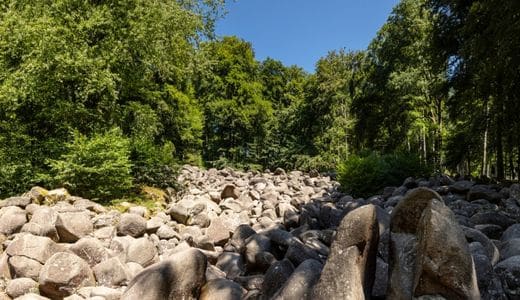
Odenwald and Bergstrasse form the UNESCO-Geo-Nature Park Bergstrasse-Odenwald and are a charming mosaic of dense forests, steep gorges, historic towns and sunlit vineyards. From the mysterious depths of the Odenwald to the blossoming gardens and vineyards along the Bergstrasse - here you will discover Germany at its most magical.
Highlights:
- Hiking and nature experiences in the Odenwald: The Geo-Nature Park Bergstrasse-Odenwald attracts visitors with its geological diversity, mystical rocky seas and extensive hiking trails such as the challenging Nibelungensteig that lead through the legendary landscape.
- The Bergstrasse : Along the route, picturesque villages and historic towns such as Weinheim and Bensheim invite you to explore. The Bergstrasse is famous for its mild climate, blossoming almond trees in spring and excellent wines.
- Heidelberg: The charming city on the Neckar enchants visitors with its historic old town, impressive castle ruins and Germany's oldest university. I'll tell you everything you can discover in Heidelberg in my article about The Most Beautiful Cities in Germany.
Places of interest:
- Lorsch Monastery: The UNESCO World Heritage Site Lorsch Monastery at the beginning of the Bergstrasse, with its Carolingian gatehouse preserved in its original appearance and the remains of the monastery complex, offers fascinating insights into the time of King Pippin, the father of Charlemagne.
- Darmstadt: Known as the "City of Science", Darmstadt impresses with the UNESCO World Heritage Site Mathildenhöhe Artists' Colony in the center of which stands the striking, 48 m high wedding tower. To the north-east of Darmstadt, the Messel Pit UNESCO World Heritage Site provides deep insights into the history of our earth.
- The historic towns in the Odenwald: Towns like Michelstadt with its famous half-timbered town hall and Miltenberg, known for its picturesque old town and the oldest inn in Germany, "Zum Riesen", invite you to make cultural discoveries.
- Felsenmeer (Sea of Rocks) in the Lauter Valley: The Felsenmeer is one of the most important geological sights in Germany. The boulders were used by the Romans and later by the Celts to quarry stone. Numerous legends surround the surreal stone landscape. According to the Nibelungen saga, Hagen von Tronje is said to have murdered Siegfried at the Siegfried Spring. There are plenty of Siegfried wells or Siegfried springs in the Odenwald - the one near Lautertal-Reichenbach is too far away from Worms - the center of the Nibelung kingdom - to be meant in the legend.
Tips for your trip:
- Best time to visit: Spring (from March), when the almond, cherry and magnolia trees are already in bloom in Germany's "spring garden", while elsewhere it is still wintry, and the autumn when the vineyards glow in golden tones and regional delicacies are served.
- Use your trip to discover the regional wines directly from the winegrowers along the Bergstrasse and to taste the local cuisine in the rustic inns and wine taverns.
- Explore the numerous cycling and hiking trails that take you to hidden treasures and breathtaking viewpoints, and let you experience the cultural diversity of the region.
From the mystical forests of the Odenwald to the sunny slopes of the Bergstrasse, from Heidelberg to Darmstadt - the Bergstrasse-Odenwald region promises unforgettable discoveries and moments of pleasure.
25. Harz Mountains: Enchanting Mountain Landscapes and Historical Treasures
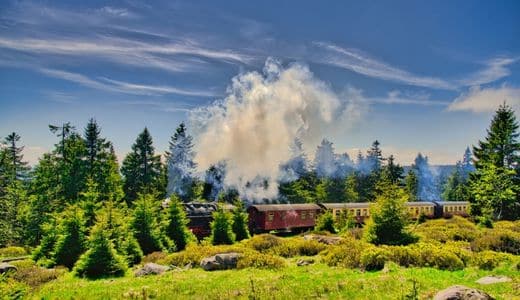
With its legendary landscape, deep forests and picturesque towns, the Harz Mountains, the highest mountain range in northern Germany, offer a unique combination of nature experiences and cultural discoveries. From the mystical Brocken, famous from Goethe's Faust, to the historic half-timbered towns of Quedlinburg and Goslar, the Harz opens up a world of adventure and history.
Highlights:
- Brocken: If you don't want to climb the Brocken on foot like Goethe, then take the Harzer Schmalspurbahn (Harz narrow-gauge railroad)! On a nostalgic journey, the steam locomotive-driven Brockenbahn takes you from Wernigerode through the picturesque landscape up to the "Blocksberg". Today, celebrating the Walpurgis Night on the Brocken is prohibited - it lies in the middle of the Harz National Park. Therefore, the Hexentanzplatz above Thale is the center of the action on the night of May 1st, when thousands of witches and devils gather for a huge spectacle.
- Hexentanzplatz (Witches' Dance Floor) and Teufelsmauer (Devil's Wall): Discover the mystical places of the Harz, rooted in ancient sagas and legends. The Hexentanzplatz offers spectacular views and cultural events, while the Teufelsmauer with its bizarre rock formations is a popular destination for hikers.
- Quedlinburg: This UNESCO World Heritage Town enchants visitors with its well-preserved medieval town center and over 2,000 half-timbered houses. A stroll through Quedlinburg is like a journey back in time.
Places of interest:
- Wernigerode: I really liked the "colorful town on the Harz" - stroll through Marktstraße to the lively market square with its magnificent town hall and colorful half-timbered houses. You can take the Bimmelbahn (tourist train) or walk to Wernigerode Castle which towers high above the city and offers not only a fascinating history, but also a magnificent view over the roofs of the city and the surrounding countryside as far as the Brocken.
- Rübeland stalactite caves: In the Baumann and Hermann Caves, you can immerse yourself in the mysterious underworld of the Harz Mountains and discover winding passages, huge cave vaults, grottos, underground lakes and even skeletons of cave bears. With the "Sky and Cave" combined ticket, you can also walk on the Titan RT suspension bridge at the Rappbode dam.
- Rammelsberg Mining Museum and the old town of Goslar (UNESCO World Heritage Site): At the Rammelsberg visitor mine in Goslar, you will learn a lot about the region's thousand-year-old mining history and gain a deep insight into the work of the miners. The old town of Goslar attracts visitors with over 1500 well-preserved half-timbered houses and picturesque alleyways.
Tips for your trip:
- Best time to travel: The Harz Mountains are an attractive destination at any time of year. While winter is perfect for winter sports and strolls through romantic Christmas markets, spring, summer and fall offer ideal conditions for hiking, cycling and cultural exploration.
- Regional specialties: Try the Harz cuisine with its hearty stews, the famous Harzer Roller and delicious cakes.
- Hiking and cycling: Take advantage of the well-developed network of hiking and cycling trails to explore the diverse landscape of the Harz Mountains. Pack sturdy shoes and remember to bring warmer clothing for a visit to the Rübeländer stalactite caves, for example.
The Harz Mountains offer a delightful mix of deep forests, myths and legends, as well as modern leisure activities. Whether you are looking for peace and relaxation, exciting adventures or are interested in the rich culture of the region - the Harz Mountains will inspire you in every respect.
26. Kyffhäuser Mountains: A Window into Germany's Legendary Past
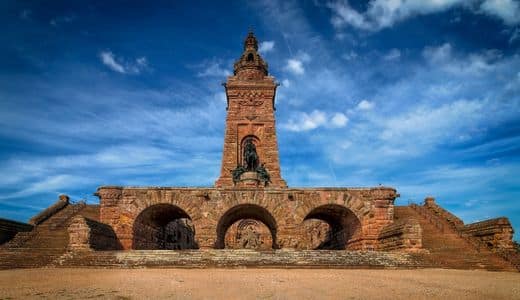
The "little brother of the Harz" is steeped in stories and legends - best known for the Kyffhäuser monument dedicated to Emperor Wilhelm I and the legend of Emperor Barbarossa, who is said to be sleeping here until Germany needs him most. This region offers one of Germany's most impressive monuments and a picturesque landscape that invites you to explore.
Highlights:
- Kyffhäuser monument: The Kaiser Wilhelm National Monument, Germany's second largest monument after the Monument to the Battle of the Nations in Leipzig, is enthroned on the Kyffhäuserberg and offers a spectacular view of the surrounding region. The monument not only tells the story of Kaiser Wilhelm I, but also the legend of Emperor Barbarossa.
- Barbarossa Cave: One of the largest anhydrite caves in the world, the Barbarossa Cave, offers a fascinating geological discovery tour. The cave is known for its underground lakes and unique rock formations, which are linked to the legend of the emperor.
- Hiking and cycling tours: The Kyffhäuser is criss-crossed by a network of hiking and cycling trails that lead through the characteristic landscape with karst areas, beech forests and many caves. The 37 km long Kyffhäuser hiking trail can be hiked in three one-day stages.
Places of interest:
- Royal Palace Tilleda: The archaeological remains of the royal palace of Tilleda at the foot of the Kyffhäuser mountains provide an insight into medieval life and the ruling structure of the time.
- Panorama Museum: This museum is located near the Kyffhäuser monument and was built from 1976 onwards on behalf of the GDR government as a memorial to the German Peasants' War. The artist Werner Tübke worked for more than a decade on the monumental painting depicting the Battle of Frankenhausen - shortly after the Panorama Museum opened on September 14, 1989, the GDR was history.
- Kyffhäuser Therme: After an eventful day, the Kyffhäuser Therme in Bad Frankenhausen offers relaxation and recreation with its thermal springs and wellness facilities.
Tips for your trip:
- Best time to travel: The region is attractive all year round, but especially in spring and fall, when the weather is ideal for outdoor activities.
- Regional cuisine: Discover the culinary tradition of the region and try local specialties such as Thuringian dumplings and Rostbrätel.
- Cultural events: In June and July, the fairytale-like backdrop of Sondershausen Castle hosts the Thuringian Castle Festival Sondershausen .
The Kyffhäuser invites you to experience nature and make historical discoveries. You can easily combine a visit to this region with a trip to the Harz Mountains.
27. The Thuringian Forest and the Hainich National Park: Natural Wonders and Cultural Treasures
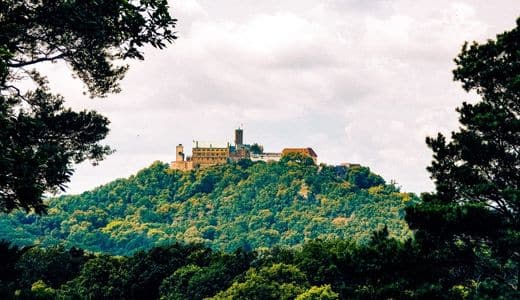
The Thuringian Forest is one of the most diverse and fascinating landscapes in Germany. This region combines the best of dense forests, picturesque valleys and historical sights. The Rennsteig is Germany's most popular long-distance hiking trail and runs 169 km along the ridge of the Thuringian Forest. To the north of it lies the Hainich, one of the last partially untouched beech forests in Europe. Part of the Hainich has been part of the UNESCO World Heritage Site Ancient and Primeval Beech Forests of the Carpathians and Other Regions of Europe.
Highlights:
- The Rennsteig: This famous hiking trail leads through the picturesque landscapes of the Thuringian Forest and combines nature experiences with cultural highlights along its route.
- Hainich National Park: During the GDR era, the Hainich was a restricted military area, which meant that the inaccessible parts of the forest remained completely untouched for decades. The World Heritage Trail gives visitors an insight into this primeval forest. On the Treetop Path you can discover the unique flora and fauna of the forest from a bird's eye view.
- Winter sports in Oberhof: The well-known winter sports center in the Thuringian Forest offers a wide range of activities, from cross-country skiing and biathlon to tobogganing and ski jumping.
Places of interest:
- Wartburg Castle: The historic castle near Eisenach, one of the six UNESCO World Heritage Sites in Thuringia, is closely linked to the story of Martin Luther and German history. Richard Wagner's opera Tannhäuser commemorates the legendary Singers' War at Wartburg Castle between Wolfram von Eschenbach, Walther von der Vogelweide and others in music. A visit to Wartburg Castle is one of the highlights of a trip to the Thuringian Forest.
- Großer Inselsberg: On the highest elevation in the western Thuringian Forest, a viewing and adventure tower offers a 360° panoramic view of the Thuringian Forest. The Großer Inselsberg is a popular starting point for hikes and nature explorations on the Rennsteig.
- Drachenschlucht (Dragon Gorge): The gorge forest near Eisenach with its narrow passages, moss-covered rock faces and the Marienbach stream is a highlight particularly for children.
- Bach House and Luther House in Eisenach: In Eisenach, the Bach House and the Luther House offer fascinating insights into the life and work of these two great Germans. The Bach House is dedicated to the music and life of Johann Sebastian Bach and offers an extensive collection of historical musical instruments as well as regular live music performances. The Luther House, one of the oldest half-timbered houses in Thuringia, provides an insight into Martin Luther's youth and his time in Eisenach, including an exhibition on his translation of the New Testament.
Tips for your trip:
- Best time to travel: The Thuringian Forest is an attractive destination at any time of year. Between May and September, mild temperatures and plenty of sunshine ensure ideal hiking conditions, while in winter, January in particular is considered snow-sure.
- Use the Thuringian Forest Card for attractive discounts and reductions on many sights and leisure activities.
- Read in my comprehensive guest article at WE TRAVEL THE WORLD which cultural highlights await you in Thuringia.
The combination of the Thuringian Forest and Hainich National Park offers a unique opportunity to experience the diversity of Germany's natural and cultural landscapes. From the deep forests of the Hainich to the historical sights and sporting challenges of the Thuringian Forest - this region promises adventure and relaxation for every taste.
How about a cultural road trip through central Germany?
The town of Eisenach in the Thuringian Forest is the starting point of the Road Trip in Eastern Germany - Cultural Route from Eisenach to Berlin in my article about the most beautiful road trips in Germany.
Save the map for your own road trip - you can customize it to your wishes. You can find out how to do this in my article How to Plan a Route with Google Maps - the Complete Guide and 3 Extra Tips
28. Saale-Unstrut: Pleasure for the Senses and Soul
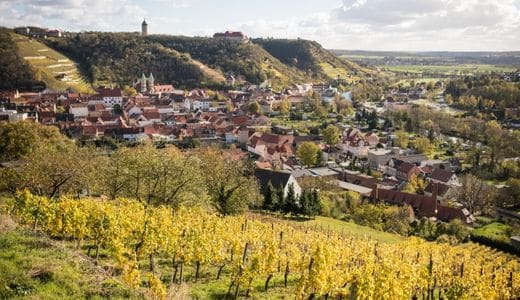
Vineyards topped by castles and fortresses, picturesque river valleys, broom taverns and wineries, with historic towns in between - the "Tuscany of the North" is still a real insider tip among Germany's most beautiful regions.
Highlights:
- Wine routes: You can explore the "land of wine and stone" along several wine routes. The best known is the 60 km long Saale-Unstrut Wine Route which begins in Memleben on the Unstrut and ends in Bad Sulza on the Saale. Wine has been cultivated on the sunlit slopes of both rivers since the Middle Ages.
- Naumburg Cathedral This late Romanesque-early Gothic jewel from the 13th century has been a UNESCO World Heritage Site since 2018. The impressive building is full of art treasures, of which the 12 donor figures in the west choir, including the famous sculpture of Uta von Ballenstedt (known as "Uta von Naumburg"), and the west rood screen - all created in the 13th century by the unnamed "Naumburg Master" - are probably the best known.
- Rotkäppchen sparkling wine cellars in Freyburg: The traditional winery in the center of the Unstrut wine-growing region was founded in 1856 and continued to operate as a VEB (state-owned enterprise) during the GDR era. In 2002, Rotkäppchen acquired the Mumm, Jules Mumm and MM brands, among others, from the Canadian Seagram Group. On a guided cellar tour, you will learn a lot about the eventful history of the company and the traditional art of sparkling wine production.
Places of interest:
- Neuenburg Castle: This imposing castle, built from the 12th century onwards, is the sister castle of Wartburg Castle. It towers over Freyburg/Unstrut and is one of the most important architectural monuments on the Romanesque Road. Neuenburg Castle was one of the oldest and most important castles of the Landgraves of Thuringia.
- Nebra Ark: About 3 km from the site of the Nebra Sky Disk In the modern visitor center, you can learn a lot about the 3,600-year-old round bronze disc, which is known to be the oldest representation of the cosmos. Today, the "Celestial Eye" is located at the discovery site itself and there is an observation tower nearby. You can see the original celestial disk in the State Museum of Prehistory in Halle.
- Memleben Monastery and Imperial Palace: In the 10th century, Memleben was an important palace under the East Frankish kings Henry I and Otto I, who both died here. Otto II, son of Otto I, together with his wife Theophanu, founded a Benedictine monasteryas a memorial to his father. Another jewel on the Romanesque Road is the Imperial Cathedral in Merseburg, the favorite place of the canonized imperial couple Henry II and Cunegonde.
- Rudolstadt: The former Heidecksburg Residential Palace is one of the most magnificent baroque palaces in Thuringia. Other well-known monuments in the city include the Ludwigsburg City Palace and St. Andrew's Church. In the Schiller House, the former home of the Lengefeld-Beulwitz family, Friedrich Schiller met his future wife Charlotte von Lengefeldt in 1787, and on September 7, 1788 his later friend Goethe for the first time.
Anja from TRAVEL ON TOAST has written a very readable blog post about her visit to the Saale-Unstrut region. At WE TRAVEL THE WORLD you will also find great tips for the area.
Tips for your trip:
- Best time to travel: From May to October, the weather is usually sunny and warm. It is particularly beautiful in autumn, when the low sun bathes the vineyards in warm light and the leaves turn orange-golden.
- Wine tastings and cellar tours: Plan a visit to one of the many wineries in the region.
With a fascinating combination of picturesque wine landscapes, historic towns and cultural heritage, Saale-Unstrut is a great destination for wine lovers, nature and culture fans who want to spend a relaxing vacation in a beautiful landscape.
29. Ore Mountains: Enchanting Landscapes and Mining Culture
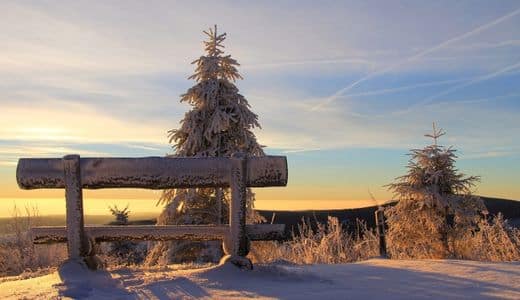
The Ore Mountains, a picturesque region on the border between Germany and the Czech Republic, is known for its rich mining tradition, fascinating craftsmanship and breathtaking landscapes. This historic region, also known as Christmas Land, offers visitors many highlights, from underground mines to high peaks.
Highlights:
- Historical mining: Immerse yourself in the mining history of the Erzgebirge by visiting a show mine, such as the Freiberg silver mine, where you can learn a lot about the hard work of the miners and silver mining in the region, both above and below ground.
- Christmas traditions and craftsmanship: Discover the unique craftsmanship of the Erzgebirge, which is known all over the world for its Christmas pyramids, nutcrackers and smokers. Visit Seiffen, the center of this tradition, where you can explore craft workshops and the toy museum.
- Hiking and winter sports: The Erzgebirge offers excellent conditions for outdoor activities, including hiking on the Erzgebirgskammweg trail, which offers spectacular views over the region, and winter sports in the many ski resorts such as Oberwiesenthal, the highest resort in Germany.
Places of interest:
- Augustusburg Castle: The "Crown of the Ore Mountains", built between 1568 and 1572 under Elector Augustus, is one of the most magnificent Renaissance castles in Central Germany, known for its impressive architecture and the motorcycle museum.
- Annaberg-Buchholz: This historic town is a center of Erzgebirge cultural heritage with impressive churches such as St. Anne's Church and the Erzgebirge Museum, which introduces visitors to regional history and culture. Between the end of November and Christmas, Annaberg-Buchholz attracts visitors with the most beautiful and famous Christmas market in the Ore Mountains.
- Fichtelbergbahn: Experience a nostalgic ride on the Fichtelbergbahn, a narrow-gauge railroad that runs through the picturesque landscape of the Ore Mountains and offers unique insights into the nature and villages of the region.
Tips for your trip:
- Best time to travel: While the Ore Mountains are worth a visit all year round, the Christmas season offers a particularly magical experience. Christian faith and deep-rooted mining traditions come together in mountain parades and processions, festivals of lights and nativity plays to create the unique Ore Mountain Christmas.
- Regional cuisine: Try local specialties such as Erzgebirgischer Stolln, a delicious variation on the traditional German Christmas stollen, and enjoy the hearty Erzgebirge cuisine.
The Ore Mountains not only impress with their picturesque landscapes, but also with a deeply rooted cultural heritage that comes alive in every village, town and festival. A visit here offers a very special blend of history, culture and nature.
30. Spreewald: A Labyrinth of Waterways and Mystical Forests
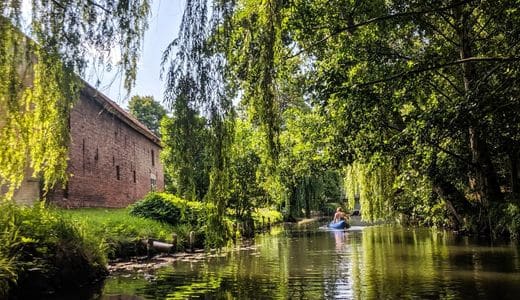
The Spreewald, located south-east of Berlin in Lower Lusatia, is a fascinating water landscape characterized by a unique network of rivers and canals. This UNESCO biosphere reserve offers impressive biodiversity and is known for its traditional boat trips, which take visitors along tranquil waterways through dense, moss-covered forests. The Spreewald is a paradise for nature lovers and water sports enthusiasts, and a cultural center of the Sorbs/Wends whose traditions and way of life characterize the area.
Highlights:
- Boat trips and paddling: Explore the idyllic waterways of the Spreewald on traditional barges. These relaxed trips offer a unique opportunity to experience the rich flora and fauna of the area at close quarters while listening to the legendary stories told by the boatmen. If you want to be active yourself, the Spreewald is one of the most beautiful paddling areas in Germany.
- Cycling and hiking trails: The Spreewald offers an extensive network of cycling and hiking trails that lead through the characteristic landscape. Discover dreamy villages, historic mills and hidden nature trails that invite you to linger and relax. The Cucumber Cycle Path is 260 kilometers dedicated to the region's most famous product, the Spreewald gherkin.
- Lübbenau: According to Theodor Fontane, the "secret capital of the Spreewald", Lübbenau is a good starting point for boat trips into the Spreewald. The harbor is also the starting point for the famous hiking trail to the Wotschofska restaurant. The Spreewald Museum offers insights into the history and traditions of the region. At Lübbenau Castle the group of conspirators around Claus Schenk Graf von Stauffenberg met to prepare the Hitler assassination attempt on July 20, 1944.
Places of interest:
- Lehde Open-Air Museum: Here you can gain an authentic insight into the traditional life of the Sorbian/Wendish and German inhabitants of the Spreewald. Historic farmhouses and craft workshops show how people once lived and worked here. The picturesque village Lehde is a district of Lübbenau and a must for every visitor to the Spreewald
- Luckau: This historic town in the heart of the Spreewald impresses with its picturesque old town and the imposing St. Nikolai Church, a masterpiece of brick Gothic architecture. Luckau is known for its well-preserved town wall, which allows you to walk along the old fortifications and gain an insight into medieval history.
- Lübben: The former capital of Lower Lusatia is a tourist center of the Spreewald. The old town fortifications are still partially preserved, and the section with the "Trutzer", a former weigh house, is considered the town's landmark. Also worth seeing are Lübben Palace with its beautiful park, which invites you to take a relaxing stroll, and the late Gothic Paul Gerhardt Church on the historic market square.
- Slavic castle Raddusch: The reconstructed Slavic castle complex offers an exciting journey into the past and explains the early history of the region. A museum within the castle provides a deeper understanding of Slavic culture and architecture.
Tips for your trip:
- Best time to travel: The Spreewald is an attractive destination at any time of year, but it is particularly appealing in spring and summer when nature is in full bloom and the waterways are at their most active. But winter also has its charm - between November and March, you can enjoy a mulled wine cruise through the frosty Spreewald. In December, the barges sail to the Christmas markets in Lübbenau and Lehde for Spreewald Christmas .
- Cultural events: Plan your visit during one of the many regional festivals, such as the Wendish carnival Zapust, Spreewald Night of Legends in Burg or the Spreewald Christmas to immerse yourself in the culture of the Sorbs.
- Culinary specialties: In addition to the famous gherkins, be sure to try other local specialties such as Spreewald fish, Schmalzstullen and Plinse.
- On the travel blog blickgewinkelt Inka has put together lots of tips for the Spreewald in a detailed article. In a separate article you will find her tips for the Spreewald in winter. She also has written two great books* about the Spreewald and Brandenburg.
The Spreewald is the ideal place for stressed city dwellers to slow down. Whether on a relaxing boat trip, a bike tour or enjoying regional delicacies - the romantic floodplain landscape appeals to all the senses and promises a relaxing vacation.
31. Upper Lusatia: Culture, History and Nature in the Far East of Germany
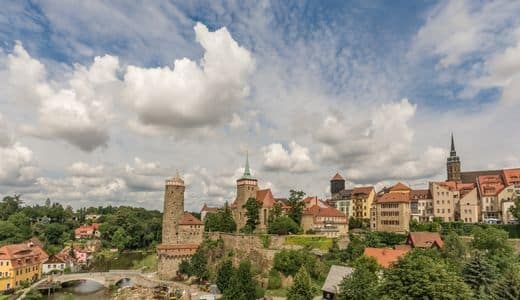
Most of Upper Lusatia is located in eastern Saxony, on the border with Poland and the Czech Republic. This region offers an interesting mix of historical heritage, largely untouched landscapes and the unique Sorbian culture. The picturesque half-timbered houses, towns worth seeing and extensive nature reserves attract both those seeking relaxation and those interested in culture.
Highlights:
- Zittau Mountains: The Zittau Mountains are part of the Sudeten Mountains and offer many hiking and cycling trails that lead through picturesque landscapes characterized by striking rock formations. One highlight is the mountain Oybin with the ruins of a medieval castle and monastery, which offers a magnificent view over the beautiful landscape.
- Muskauer Park/Park Mużakowski: Designed by Prince Pückler, Muskauer Park is the largest English-style landscape park in Central Europe. This cross-border UNESCO World Heritage Site. stretches between Germany and Poland and is ideal for wonderful walks.
- Upper Lusatian heath and pond landscape: This extensive UNESCO biosphere reserve is one of the most important wetlands in Germany and a paradise for birdwatchers and nature lovers. The region is known for its unique landscape of heathland, forests and over 350 ponds and lakes, which are important resting and breeding grounds for numerous bird species - including rare ones such as the white-tailed eagle. One of the 49 mammal species native to the region is the wolf. Spree photographer Karsten Nitsch offers wolf excursions for small groups of up to four people.
- Umgebindehaus architecture: There are still around 6,000 of the characteristic half-timbered houses in Upper Lusatia. These traditional houses combine log, half-timbered and solid construction and can be seen particularly between Zittau, Görlitz and Bautzen. In Obercunnersdorf there are still around 250 of these houses.
Places of interest:
- Bautzen: The over 1,000-year-old town of Bautzen impresses with its medieval architecture, such as the Alte Wasserkunst (Old Waterworks), St. Michael's Church and the "leaning tower of Bautzen", the Reichenturm. The city is the center of the Upper Lusatian Sorbs. The pop band Silbermond and the famous Bautzen mustard come from here.
- Görlitz: Germany's easternmost city is often referred to as "Görliwood" because its well-preserved old town with 4,000 monuments from 500 years of history has served as the backdrop for films such as "Inglorious Bastards" and "Grand Budapest Hotel".
- Herrnhut: The founding site of the Moravian Church (internationally known as the Moravian Church) has been part of the UNESCO World Heritage Site "Settlements of the Moravian Church" since 2024. A special feature is the "Herrnhut Baroque", the uniformly simple architectural style in the settlements of the Moravian Church around the world. Herrnhut is also the origin of the famous poinsettias with 25 points - 17 square and 8 triangular - which are produced in Herrnhut and sold worldwide.
- Former lignite mining areas: The Lusatian Lakeland, an area created by the flooding of former opencast mines, is developing into Europe's largest artificial water landscape. The approximately 175 square kilometer region of flooded lakes and navigable canals offers countless leisure opportunities and nature experiences. The recultivation areas of the open-cast lignite mine were also used to create the Nochten boulder park, a unique garden world in which 7,000 Scandinavian boulders are embedded. The carefully designed landscapes and themed gardens make the award-winning complex a visual experience.
- Rakotz bridge in Kromlau: At the Rhododendron Park Kromlau the spectacular stone bridge, which together with its reflection in the Rakotzsee lake forms a perfect circle in good weather conditions, attracts photographers and Instagrammers from all over the world. A visit to the park is an absolute highlight, especially when the rhododendrons and azaleas are in bloom in May.
Tips for your trip:
- Best time to travel: Upper Lusatia is attractive all year round. Summer offers ideal conditions for hiking and water sports, while winter dreams come true here in the cold season.
- Regional cuisine: Be sure to try the Sorbian specialties such as wedding soup and pancakes.
- Events: Upper Lusatia is the center of Sorbian culture in Germany. The traditional Sorbian festivals, such as the Bird Wedding (January 25), the Easter Ride and the Burning of the Witches (April 30) offer special insights into Sorbian culture.
Upper Lusatia offers a fascinating combination of nature, history and culture. With its unique Sorbian tradition, picturesque landscape and historic towns, the region offers unforgettable experiences at any time of year.
32. Saxon Switzerland: Breathtaking Rock Formations and Picturesque Panoramas

Saxon Switzerland in eastern Germany, close to the Czech border, is one of the most spectacular natural landscapes in Europe. This region is famous for its striking sandstone cliffs and deep gorges, which form part of the Elbe Sandstone Mountains. Romantic artists such as Caspar David Friedrich with his famous work Wanderer above the Sea of Fog, Carl Maria von Weber, who wrote the Wolf's Glen scene of his Freischütz settled near Rathen and Richard Wagner's Lohengrin contributed to the region's popularity as a tourist destination.
Highlights:
- Bastei bridge: The iconic Bastei Bridge offers one of the most impressive views in Saxon Switzerland. Situated high above the Elbe, it offers spectacular views of the surrounding rock formations and is a must-see for every visitor.
- Königstein Fortress: One of the largest mountain fortresses in Europe, Königstein Fortress, sits majestically on a rocky plateau and, in addition to its impressive architecture and history, offers a breathtaking panoramic view of the Elbe Valley.
- Boofing in the national park: A special way to experience the region is boofening - spending the night in the open air in specially designed rock overhangs, a tradition that is very popular with climbers.
Places of interest:
- Kirnitzschtalbahn: The historic streetcar through the picturesque Kirnitzschtal valley offers a relaxing way to explore the region's deep forests and rocky gorges.
- Schrammsteine: An impressive group of rocks known for its spectacular viewpoints and challenging climbing routes. Hikes here take you through some of the most striking landscapes in Saxon Switzerland.
- Barbarine on the Pfaffenstein: The Barbarine, a famous rock needle, is the landmark of Saxon Switzerland and a popular destination for photographers and hikers.
Tips for your trip:
- Best time to travel: Saxon Switzerland is attractive all year round, but especially in spring and fall, when the temperatures are ideal for outdoor activities.
- Hiking and climbing equipment: Pack the right equipment to enjoy the many hiking and climbing opportunities safely and comfortably.
- Regional cuisine: Try typical regional dishes such as Quarkkeulchen, Saxon bacon dip, green dumplings and Saxon-style sauerbraten in the numerous inns and restaurants along the Elbe.
Saxon Switzerland combines breathtaking natural beauty with deeply rooted culture and history. Whether you follow in the footsteps of the Romantics, climb the imposing rock formations or simply relax in the untouched nature - this region offers unforgettable experiences for every visitor.
The South
In the south of Germany, an impressive variety of landscapes and deeply rooted cultural traditions come together. To foreigners, this is the best-known and most popular part of the country. From the imposing peaks of the Bavarian Alps to the mysterious trails of the Black Forest and the northern Alps at the "Swabian Sea", Lake Constance, one highlight follows the next. Discover magnificent castles, follow in the footsteps of the Romans along the Danube, or simply enjoy the hearty southern German cuisine in a cozy beer garden. The region is a melting pot of history, culture and nature that delights both adventure-seekers and those looking for relaxation.
33. Saarland: A Cultural Mosaic in the Heart of Europe
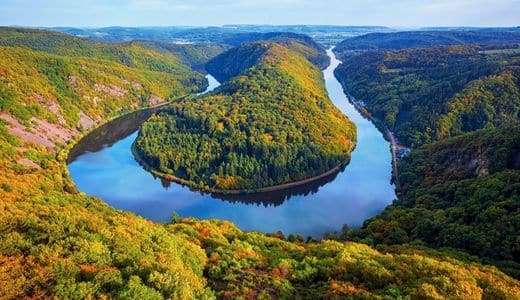
The Saarland, small but mighty, offers an impressive variety of cultural and natural sights. The region on the border with France and Luxembourg is rich in historical sites, industrial culture and beautiful nature. From the vibrant life in Saarbrücken to the UNESCO World Heritage Site Völklingen Ironworks to the picturesque landscapes along the Saar Loop - the Saarland has something for everyone.
Highlights:
- Hikes around the Saar Loop: From the Cloef viewpoint you have the best view of the Saarschleife (Saar Loop). The low-barrier Treetop Walk, Saarschleife takes you through the treetops at a height of up to 23 meters and ends on a viewing tower, which offers a magnificent 360-degree view over the Saar Loop and, on a clear day, as far as the Vosges Mountains. The popular Saar-Hunsrück Climb offers a variety of hiking routes through this picturesque region.
- Völklingen Ironworks: The former ironworks is one of the most impressive industrial monuments and has been a UNESCO World Heritage Site. since 1994. Now a cultural center, it attracts visitors from all over the world with exhibitions, concerts and events.
- Saarbrücken: The state capital combines French charm with German culture. Discover historical sights such as the Saarbrücken Castle and Ludwigskirche, stroll through the picturesque streets of the old town around the St. Johann market or enjoy the diverse gastronomy.
Places of interest:
- Tholey Abbey Church: The church of the oldest monastery on German soil was extensively renovated between 2018 and 2020. The three windows in the main choir designed by Gerhard Richter harmonize surprisingly well with the figurative motifs of the other windows in the church, which were designed by the German-Afghan artist Mahbuba Elham Maqsoodi.
- Homburg Schlossberghöhlen (Castle Caves): The largest red sandstone caves in Europe offer a unique underground experience. Explore the extensive cave systems and learn more about their geological and historical significance.
- Saarburg: A charming excursion destination near the Saar Loop is the picturesque little town of Saarburg (Rhineland-Palatinate), known for its impressive waterfall in the middle of the city and the historic castle that towers over it.
- St. Wendel: With its picturesque market square and the Basilica of St. Wendelin, St. Wendel offers a charming mix of history and modern city life. In December, St. Wendel hosts the most beautiful Christmas market in Saarland .
Tips for your trip:
- Best time to travel: The Saarland is an attractive destination all year round, but it is particularly attractive in spring and autumn when nature is at its most beautiful.
- Culinary discoveries: The Saarland is known for its culinary diversity. Be sure to try Saarland specialties such as Lyoner, Schwenker and Dibbelabbes.
- Cross-border excursions: Take the opportunity for day trips to France and Luxembourg, which are both just a stone's throw away.
- City tip: A trip to the Saarland can easily be combined with a visit to the UNESCO World Heritage City of Trier - Germany's oldest city.
The Saarland, often underestimated, offers an amazing mix of culture, history and nature. It is an ideal destination for those who want to experience the interplay of European cultures and explore the less traveled paths.
34. Rhön: The Land of Endless Horizons
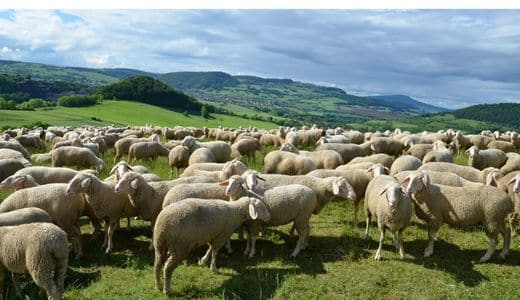
The Rhön, known as the "land of endless horizons", is an impressive low mountain range landscape in the heart of Germany that stretches across the federal states of Bavaria, Hesse and Thuringia. The UNESCO Rhön Biosphere Reserve offers untouched nature, extensive hiking trails and a rich history. With its wide plateaus, volcanic cones and deep valleys, the Rhön is a paradise for nature lovers, hikers and anyone looking for peace and relaxation in nature.
Highlights:
- Wasserkuppe: As the highest elevation in the Rhön, the Wasserkuppe not only offers fantastic views over the entire region, but is also the "cradle of gliding". Here you can go paragliding, gliding, or skiing and snowboarding in winter.
- Rhön Star Park: The UNESCO Rhön Biosphere Reserve was designated an "International Star Park" by UNESCO in 2014. The sparsely populated Rhön offers one of the best opportunities in Germany to observe the night sky in all its glory and without light pollution. On guided night-time hikes with certified star guides, you can learn a lot about the northern night sky, the North Star, constellations and planets.
- Schwarzes Moor (Black Moor): Another natural highlight is the Schwarze Moor, one of the largest and best-preserved raised bogs in Germany. A wooden boardwalk leads through the unique flora and fauna of this fascinating landscape.
- Milseburg: The Milseburg, for many the most beautiful mountain in the Rhön, is rich in prehistoric sites such as the Oppidum Milseburg, the most important ring wall site in the Rhön, and offers excellent hiking opportunities with spectacular panoramic views.
Places of interest:
- Kreuzberg Monastery: Visit the Kreuzberg Monastery, which is not only known for its architecture and picturesque location, but also for its traditional monastery brewery, which treats visitors to home-brewed beer.
- Point Alpha: This former US military camp on the border between Hesse and Thuringia is now a museum and memorial documenting the division of Germany and the Cold War.
- Baroque city of Fulda: With the impressive St. Salvador Cathedral and the magnificent city palace, a picturesque old town and interesting museums, Fulda is an insider tip among Germany's beautiful cities.
Tips for your trip:
- Best time to travel: The Rhön is an attractive destination all year round. While summer is ideal for hiking and cycling, the region transforms into a popular destination for winter sports enthusiasts in the colder months.
- Regional cuisine: Enjoy the local cuisine, which ranges from stuffed lamb rolls from Rhön sheep to traditional potato dishes and hearty sausages.
- Beautiful cities: If so much nature draws you back to a city, then the Rhön has something for you besides Fulda: On the Rhön periphery the UNESCO World Heritage City of Bad Kissingen as one of the Great Spa Towns of Europe, and - southwest of the Thuringian Forest - the historic half-timbered town of Schmalkalden with its listed old town and fascinating history.
With its high moors, barren hilltops, volcanic rock and harsh climate, the Rhön is not a tourist hotspot, but a perfect retreat for nature lovers seeking peace and quiet.
35. Fichtelgebirge: Natural Paradise between Peaks and Traditions
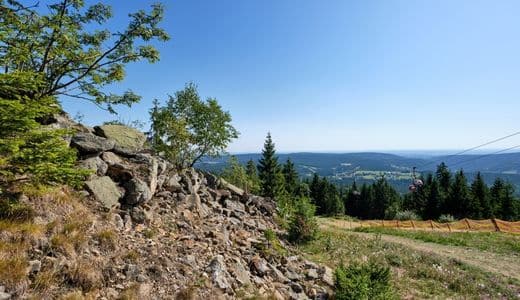
The Fichtelgebirge mountains rise up to 1,000 m in the north-east of Bavaria and are characterized by their unique rock formations, extensive forests and crystal-clear lakes. The region is a paradise for nature lovers, hikers and winter sports enthusiasts, with well-marked hiking trails, challenging mountain bike routes and family-friendly ski resorts. With numerous castles, palaces, churches and the UNESCO World Heritage City of Bayreuth this part of Germany also has a lot to offer culturally.
Highlights:
- Schneeberg and Ochsenkopf: The highest peaks in the Fichtelgebirge, Schneeberg and Ochsenkopf, offer breathtaking views and are popular destinations for hiking tours and skiing in winter. At an altitude of 1053 meters, the Schneeberg is the highest peak in the Fichtelgebirge. As it is located in a nature reserve, it can only be reached on foot or by bike. The Fichtel Mountains are home to some of the best Mountain bike trails in Germany. The Bikepark Ochsenkopf is particularly popular with downhill riders. In summer there are two cable cars that take visitors to the summit of the Ochsenkopf.
- Luisenburg rock labyrinth: This natural wonder of gigantic granite blocks near Wunsiedel is one of Germany's oldest tourist attractions - Goethe himself explored the dramatic landscape. The bizarre rock formations have been shaped by erosion over 300 million years. You'll need sturdy shoes here - you'll be walking over scree, up steep steps and through crevices.
- View of the twelve peaks near Röslau: This spectacular vantage point is the geographical center of the region and offers a unique view over all twelve peaks of the Fichtelgebirge. The viewpoint, which is 602 m above sea level, can be reached by car and is located just outside Röslau.
Places of interest:
- German Steam Locomotive Museum: Neuenmarkt is home to this unique museum, which documents the history of steam locomotives in Germany and offers an impressive collection of historic locomotives. A paradise for railroad fans!
- Waldsassen Abbey: This magnificent baroque basilica is one of the most impressive baroque buildings in southern Germany. The monastery also houses an amazing library with thousands of historical books.
- Porcelain city of Selb: If you need new crockery, you can go to the Rosenthal Outlet Center in Selb with products from Hutschenreuther, Thomas and, of course, Rosenthal. The Porzellanikon Selb is home to the State Museum of Porcelain, which was established in 1969 in the disused Rosenthal factory and provides information about the history and technology of porcelain production.
Tips for your trip:
- Best time to travel: The Fichtelgebirge is an attractive destination all year round. Summer offers ideal conditions for hiking and cycling tours, while winter is particularly popular with skiers and snowboarders.
- Relaxation in spas and thermal baths: Treat yourself to a day of relaxation in one of the thermal baths in Weißenstadt, Bayreuth or Bad Alexandersbad.
- Trip to Bayreuth: Located between the Fichtelgebirge and Franconian Switzerland, Bayreuth attracts culture enthusiasts from all over the world every year with the Richard Wagner Festival. The Margravial Opera House, part of the UNESCO World Heritage, impresses with its magnificent baroque architecture. In addition, the beautiful old town of Bayreuth, the New Palace with the Court Garden, the Hermitage, the Richard Wagner Museum in the Wahnfried House, the baroque synagogue from 1760, many other interesting museums and Maisel's Beer Experience World offers a potpourri of options.
The varied landscape of the Fichtelgebirge invites you to enjoy outdoor activities all year round. In beautiful Bayreuth and in the castles, churches and palaces of the region, culture lovers also get their money's worth.
36. Franconian Switzerland: Castles, Caves and the Art of Brewing
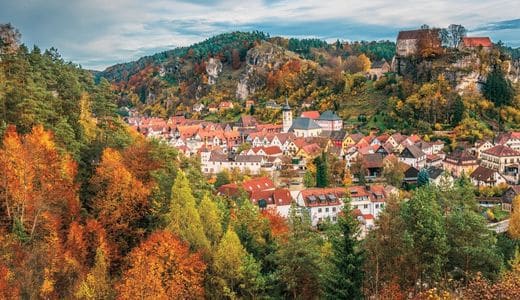
Franconian Switzerland in the heart of Bavaria is one of the oldest and most popular vacation regions in Germany. Romantics such as the young writer Ludwig Tieck discovered the "Muggendorfer Gebürg" as a hiking region at the beginning of the 19th century. Characterized by bizarre rock formations, deep valleys, castles and stalactite caves, the idyllic landscape is a dream destination for hikers, climbers and nature lovers. The region is also famous for its traditional festivals and the unique density of breweries and beer cellars where Franconian beer culture is celebrated.
Highlights:
- Climbing, hiking and canoeing: Franconian Switzerland offers an extensive network of hiking trails and some of the best climbing crags in Germany. Well-known trails such as the Franconian Trail lead through spectacular karst landscapes and past historic mills and castles. The Wiesent is the main river in Franconian Switzerland and a well-known canoeing area.
- Speleology: Explore the numerous caves in the region, including the Devil's Cave (Teufelshöhle) Pottenstein, one of the largest stalactite caves in Germany, and the St. Sophia's Caveknown for its impressive stalagmites, such as the "Millionaire" and the sinter flags which are up to three meters long.
- Cherry blossom: Every spring, Franconian Switzerland - one of the largest cherry-growing regions in Germany -transforms into a sea of pink and white blossoms. This natural spectacle not only attracts photographers and nature lovers, but also marks the start of the cherry season, which is accompanied by many festivals.
- Brewery culture: Franconian Switzerland is known for its high density of traditional breweries. A highlight for beer drinkers is the Forchheimer Kellerwald. In Forchheim's 23 rock beer cellars, you can sit under shady trees in what is probably the largest beer garden in the world.
Places of interest:
- Walberla: Officially known as Ehrenbürg, this table mountain is the striking and popular landmark of Franconian Switzerland. Crowned by the remains of two medieval castles, it offers a spectacular view of the surrounding landscape. On the first Sunday in May, the traditional Walberla Festival is celebrated here on the plateau, Germany's oldest spring festival, which treats visitors to local specialties, music and a unique panorama.
- Pottenstein Castle: This imposing castle towers majestically over the town of the same name and offers a fascinating insight into Franconian history as well as a magnificent view. The castle is said to have been the stronghold of Elisabeth of Thuringia from 1227 to 1228, who was later canonized.
- Basilica Gößweinstein: The magnificently decorated pilgrimage church designed by Balthasar Neumann is the spiritual center of Franconian Switzerland. The basilica and the picturesque Gößweinstein Castle make the climatic health resort Gößweinstein one of the most visited places in Franconian Switzerland.
- Forchheim: The "Gateway to Franconian Switzerland" with its well-preserved half-timbered old town was once a Carolingian royal palace. Later, the Bamberg prince-bishops had Forchheim developed into a fortress town. The so-called "Kaiserpfalz" was built in the 14th century as a secondary residence for the bishops.
- Be sure to also visit Nuremberg and Bamberg, which are most interesting cities in Germany and are only a stone's throw away from Franconian Switzerland.
Tips for your trip:
- Best time to travel: Although Franconian Switzerland can be visited all year round, the warm season is particularly attractive for enjoying Franconian beer garden culture to the fullest. The cherry blossom in spring is a feast for the eyes!
- Culinary delights: In addition to the famous beer, you should also try regional specialties such as Schäufele, carp and Franconian sausages, which are offered in the local inns and beer cellars.
- Festivals and events: Plan your visit during the traditional church fairs, the Walberla Festival or when the fountains are festively decorated at Easter time to experience the cultural diversity of the region.
From breathtaking landscapes to culinary delights, a visit to Franconian Switzerland promises unforgettable experiences and deep insights into the Franconian way of life.
37. The Picturesque Altmühl Valley: a Bavarian Experience of Nature and Culture
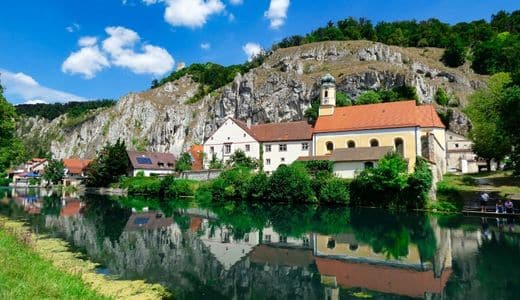
In the heart of Bavaria, the Altmühltal captivates visitors with its gently undulating landscape, geological wonders and rich cultural heritage. The idyllic valley, crossed by the river Altmühl, offers nature experiences, prehistoric sites and picturesque villages. Whether hiking, cycling or on a leisurely boat trip - the Altmühltal invites you to forget time and unwind.
Highlights:
- Weltenburger Enge: This spectacular river strait at the Danube Gorge is one of the highlights of the Altmühltal. The steep limestone cliffs that rise up on both sides of the Danube provide a dramatic backdrop for boat trips and hikes. Between the small village of Weltenburg and the Danube gorge lies the Weltenburg Monastery, which was decorated by the Asam brothers in the 18th century. The abbey church is considered a masterpiece of European baroque architecture. The award-winning beers from the monastery brewery can be enjoyed in the idyllic beer garden with delicious Bavarian delicacies. Boat trips are offered between Kelheim and Weltenburg, where you can marvel at the steep cliffs of the Weltenburg gorge from a breathtaking perspective.
- Hiking, cycling and boating along the Altmühl: In the Altmühltal Nature Park, one of the largest in Germany, you can experience the unique landscape of rock formations, Jura plateaus and river valleys in a variety of ways. The Altmühltal cycle path is well developed and one of the most popular cycle paths in Germany. You can explore the 120 km between Gunzenhausen and Dietfurt by boat or canoe in several stages. If you like hiking, the Altmühltal Panorama Trail takes you to the most beautiful places in the river valley, such as the Twelve Apostles, a steeply rising group of rocks near Solnhofen.
- Castles and palaces: Many picturesque castles and palaceswhich are well worth a visit are towering high above the Altmühltal. The Prunn Castle is considered the most beautiful castle in the Altmühltal, from Randeck Castle you have a magnificent view of the valley landscape around the medieval town Essing, one of the most picturesque places in the Altmühltal. In my article about the differences between castles, palaces and palaces I clarify some of the misunderstandings around these terms.
Places of interest:
- Eichstätt Jura Museum: This museum at Willibaldsburg Castle in Eichstätt is a must for fossil enthusiasts. It displays an outstanding collection of fossils from the Jurassic Sea that were found in the region, including the famous Archaeopteryx.
- Baroque city of Eichstätt: The capital of the Altmühltal fascinates with its rich Baroque heritage, which is particularly evident around the Residenzplatz designed by Gabriel de Gabrieli. Eichstätt Cathedral is also an architectural masterpiece with magnificent altars and an impressive organ.
- Kelheim and the Befreiungshalle (Liberation Hall): Located at the confluence of the Danube and Altmühl rivers, Kelheim is the last town in the Altmühltal valley. The town is primarily famous for the monumental Befreiungshalle (Liberation Hall), which King Ludwig I of Bavaria had built in honor of the victories in the Napoleonic Wars of Liberation. A visit to the impressive building is also worthwhile because of the fantastic view over the surrounding area. From Kelheim, you can take a boat trip to the Danube Gorge and Weltenburg Abbey.
- Weißenburg in Bavaria: Weißenburg is home to the Limes Museum for the Bavarian section of the UNESCO World Heritage Site Frontiers of the Roman Empire - Upper German-Raetian Limes. The city is also famous for its impressive Roman excavations, including the Biriciana Castle, the best-preserved Roman fort in Bavaria. The Roman Museum presents one of the most important Roman treasures ever found in Germany. Take a stroll through Weissenburg's old town and discover the town's charming baroque and medieval architecture.
Tips for your trip:
- Best time to travel: The Altmühltal is a particularly attractive travel and excursion destination between May and October when the temperatures are ideal for outdoor activities.
- Culinary delights: Try regional specialties such as Altmühltal roast lamb, trout and Abensberg asparagus.
- Events and festivals: Find out about the numerous events in the Altmühltal, such as the many historical festivals or the Eichstätt Music Festival, that enrich the region's cultural life.
- Best travel guide for the Altmühltal: On my trip through the Altmühltal I used the travel guide Altmühltal - Franconian Lake District by Michael Müller Verlag*, which contains all the information on the sights of the Altmühltal and the Franconian Lake District, including service tips and many suggestions for hiking, cycling and boat tours. I found this travel guide super helpful.
In the Altmühltal, you can immerse yourself in German history, explore the beautiful natural surroundings and unwind in one of the most picturesque landscapes in Germany.
38. Mainfranken: Cultural Treasures and Wine Experiences
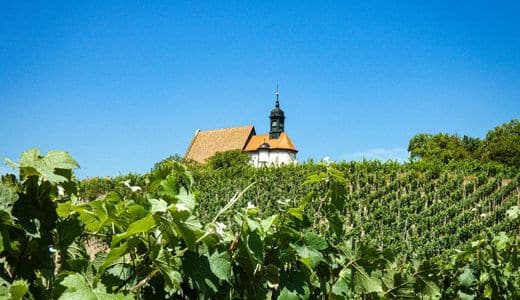
The Franconian wine-growing regions along the River Main between Würzburg and Aschaffenburg attract visitors with their deep-rooted wine tradition and rich culture, picturesque countryside and historic towns. Here, cultural diversity and a flourishing wine culture combine to create a unique travel destination.
Highlights:
- Würzburg: The former prince-bishop's residence city of Würzburg delights visitors with its baroque Residence and the palace gardens which are UNESCO World Heritage Site. the venerable Marienberg Fortress and a diverse cultural life. It is a must for every visit to Mainfranken. In my article Würzburg Sightseeing - the Complete City Guide (with Map) I show you Würzburg's most important sights, including a suggestion for a walking tour, on which you can discover the city's highlights in one day.
- Wine Festivals: Almost all year round wine festivals take place in the region, celebrating Mainfranken's excellent wines. Special highlights are the wine festivals in well-known wine villages such as Iphofen, Volkach and Prichsenstadt, which are known for their hospitality and picturesque towns.
- Steigerwald: You can explore the Steigerwald with its mixture of dense beech forests and rolling hills on picturesque hiking trails. The pretty villages around the Steigerwald such as Iphofen, Prichsenstadt, Ebrach or Castell are ideal locations for nature and wine lovers who want to enjoy the local specialties while discovering the largely untouched landscape. On the Tree Top Walk Steigerwald near Ebrach you can experience the forest at lofty heights.
Places of interest:
- Miltenberg: This charming medieval town on the River Main boasts a well-preserved old town with narrow streets and half-timbered houses that provide a romantic backdrop.
- Volkach: The picturesque wine village is known for the pilgrimage church Maria im Weingarten with a famous late work by Tilman Riemenschneider, the "Maria im Rosenkranz", and as the center of Franconian viticulture.
- Wertheim: Situated at the confluence of the Main and Tauber rivers, Wertheim offers a picturesque old town with an impressive castle and beautiful views of the surrounding vineyards.
Also read my article Day Trips from Würzburg - the 11 Most Beautiful Destinations, in which I show you many beautiful places around Würzburg.
Tips for your trip:
- Best time to travel: Visit Mainfranken in spring or autumn to experience the vineyards in their most beautiful colors or during the grape harvest. These seasons offer ideal conditions for outdoor activities such as hiking and cycling.
- Regional specialties: Taste the famous Silvaner or Müller-Thurgau wines with traditional dishes such as Franconian Sauerbraten or Schäufele.
- Culture and Events: The region is rich in cultural events, including the Kiliani folk festival in Würzburg and numerous local church festivals, which are celebrated in many villages and are deeply rooted in Franconian culture.
Mainfranken is a mosaic of cultural highlights and vinophile delights. Whether you are interested in history and culture or want to enjoy fine Franconian wines, Mainfranken offers countless opportunities for a relaxing and varied vacation in a fascinating scenic and cultural environment.
39. Bavarian Forest: Untouched Wilderness and Traditional Culture
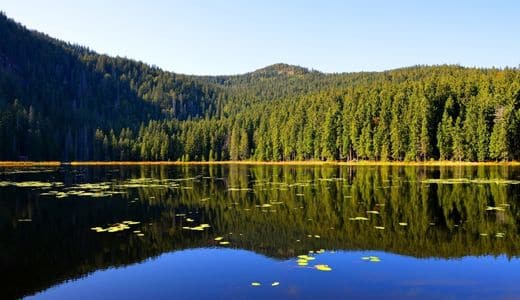
The Bavarian Forest lies on the border with the Czech Republic and is one of the last large wilderness areas in Europe. It offers a fascinating mixture of dense forests, crystal-clear lakes and mystical mountain peaks.
Highlights:
- Bavarian Forest National Park: Germany's first national park invites visitors to explore the local flora and fauna. With its network of hiking trails, nature trails and visitor centers, the national park offers deep insights into the conservation and habitats of the Bavarian Forest. You can see the animals that were once or are again native to the region, such as lynxes, brown bears, wild cats and wolves, on the 7-kilometre circular trail around the outdoor animal area at the Lusen National Park Center.
- Treetop Walk at the Lusen National Park Center: This impressive treetop walk takes you along a 1,300-metre barrier-free path to the spectacular viewing platform in the "tree egg". Here you can let your gaze wander over Central Europe's largest contiguous forest reserve, which the Bavarian Forest forms together with the neighboring Šumava National Park in the Czech Republic.
- Großer Arbersee and Großer Arber: The Großer Arber, known as the "King of the Bavarian Forest", and the picturesque Großer Arbersee lake offer unique nature experiences from hikes and relaxing walks around the lake to skiing and snowboarding in winter.
Places of interest:
- Passau: The "City of Three Rivers" is picturesquely situated at the confluence of the Danube, Inn and Ilz rivers. Its unique geographical location offers breathtaking views and makes it a popular destination for river cruises. Passau is famous for its impressive St. Stephen's Cathedral, which houses the world's largest church organ. The winding streets of the old town are characterized by baroque architecture, cozy cafés and small stores.
- Bodenmais: The most visited town in the Bavarian Forest is particularly famous for its glassblowing art. A highlight is the Joska Crystal World where visitors can not only experience the fascinating art of glassblowing live, but also admire and purchase unique glass objects.
- Metten Monastery: This Benedictine abbey is known for its impressive baroque architecture and the magnificently furnished library, which is considered one of the most beautiful monastery libraries in Bavaria.
- Asam Basilica in Osterhofen-Neumarkt: The Asam Basilica, officially known as the collegiate church of St. Margareta, is a magnificent example of Baroque church architecture. It was designed by the architect Johann Michael Fischer and furnished by the famous Asam brothers.
Tips for your trip:
- Best time to travel: The Bavarian Forest is worth a visit all year round. Ideal for hiking and exploring nature in summer, the region is a popular destination for cross-country skiing and other winter sports in winter.
- Culinary delights: Enjoy local specialties such as Bavarian forest honey, blood and liver sausages and traditional Bavarian beer in the numerous inns.
- Events and festivals: Visit local festivals such as the Wolf release , the Easter ride in Regen or the Whitsun ride in Bad Kötzting.
Whether you are looking for relaxation in nature, active outdoor adventures or an insight into the traditions of Bavaria, the Bavarian Forest offers unforgettable experiences.
40. Experience the Black Forest: A Symphony of Forests, Wine and Water

The Black Forest, one of Germany's most popular and picturesque vacation regions, attracts visitors with its dense, dark forests, traditional Black Forest farms and world-famous spas. Everything that is considered "typically German" in the world comes from here: Bollenhüte, kirsch schnapps, cuckoo clocks. None of them exists in my household 😅.
Highlights:
- Black Forest hiking routes: Explore the numerous hiking trails that lead through the breathtaking landscapes of the Black Forest. The Feldberg, the highest peak in the region offers spectacular views and is a popular destination for hikers, and for skiers in winter.
- Black Forest High Road: The Black Forest High Road winds its way spectacularly over 60 km through the heights of the Black Forest and offers breathtaking views of the surrounding valleys and forests. It is one of the oldest and most famous tourist routes in Germany and connects Freudenstadt, known for the largest market square in Germany, with the elegant spa town of Baden-Baden)which is part of the UNESCO World Heritage The Great Spa Towns of Europe. Directly on the route, at the foot of the highest mountain in the northern Black Forest, the Hornisgrinde, lies the largest and most beautiful of the Black Forest cirque lakes, the legendary Mummelsee.
- Titisee: Lake Titisee is one of the most famous lakes in the Black Forest and a popular destination for tourists from all over the world. In the middle of the picturesque landscape, the very touristy lake provides a perfect backdrop for water sports such as swimming, sailing and boating. The lakeside promenade is lined with cafés and stores selling traditional Black Forest products - including cuckoo clocks, which are particularly popular with Asian visitors. A boat trip on Lake Titisee is a wonderful way to enjoy the relaxed atmosphere of the Black Forest.
- Baden Wine Route: Always along the Black Forest, this popular vacation route - one of the most beautiful in Germany - leads from Baden-Baden through the Baden wine regions such as Ortenau, Breisgau, Kaiserstuhl and Markgräflerland to Basel. On this route, you can taste some of Germany's best wines and experience the picturesque vineyards, old winegrowing villages and traditional wine festivals.
Places of interest:
- Freiburg im Breisgau: This lively university town is known for its mild climate, historic old town and impressive cathedral. Freiburg is one of the most beautiful cities in southern Germany and the ideal starting point for exploring the southern Black Forest. Take the cable car or hike to the top of the Schauinsland, Freiburg's local mountain, which offers spectacular views.
- Triberg waterfalls: The seven cascades of Germany's highest waterfalls plunge over a total of 162 m into the Gutach valley. You can see the world's largest cuckoo clock in the Eble Watch Park. But also the Black Forest Museum and pilgrimage church Maria an der Tanne are worth a visit.
- Vogtsbauernhof Open-Air Museum: This impressive open-air museum in the heart of the Black Forest offers an authentic insight into rural life in the region over several centuries. The Vogtsbauernhof and other reconstructed farmhouses from various parts of the Black Forest showcase traditional architecture and lifestyles.
Tips for your trip:
- Best time to travel: The Black Forest is charming all year round. Summer is ideal for hiking and cycling, autumn entices with its colorful splendor, winter enchants with snow and the spring months are perfect for watching nature awaken.
- The drive along the Black Forest High Road, which is a visual experience, especially in fall and spring. You should avoid weekends, public holidays and vacation periods if possible, since the route is popular with locals and tourists.
- Culinary highlights: In the Black Forest (especially in Baiersbronn, Sasbachwalden and Baden-Baden)you will find some of the most famous gourmet temples and luxury hotels in Germany. Of course, the typical Black Forest specialties - Black Forest ham, Black Forest cake and Black Forest kirsch (a high-proof schnapps) - are simply part of a trip to this region.
- Black Forest Card: If you are staying in the Black Forest for at least three days, the Black Forest Card, which includes free admission to numerous attractions, can be worthwhile. There are two variants - including 1 day Europa-Park or without.
A visit to the Black Forest takes you into a world where nature often still sets the tone and the clocks seem to tick slower than elsewhere. At the same time, it's never far to the nearest charming city such as Baden-Baden in the north or Freiburg in the south, which offer a wide range of cultural attractions. A trip to France to the beautiful Alsace region with cities worth seeing such as Strasbourg and Colmar is also worthwhile.
41. between metropolis and nature: cultural treasures and wine trails in the Middle and Upper Neckar Valley
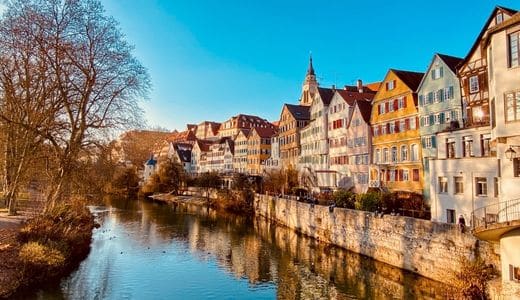
With picturesque vineyards, charming towns, the easily accessible Black Forest and the Swabian Alb, the Stuttgart region offers a fascinating mix of urban flair and nature experiences. The Neckar valley is lined with steep vineyards, medieval castles and picturesque villages, and offers numerous opportunities for exploring on foot, by bike or on the water.
Highlights:
- Stuttgart: The state capital of Baden-Württemberg is a center for culture, art and innovation. Visit the Mercedes-Benz Museum, the State Gallery or experience the lively theater scene. Stuttgart is also the perfect starting point for exploring the region.
- Wine trails: Explore the idyllic wine trails that run through the Neckar Valley. These routes not only offer breathtaking views, but also the opportunity to taste some of the region's best wines.
- Hessigheim rock gardens, Known as the "Swabian Dolomites", the Hessigheim rock gardens offer a spectacular backdrop for nature lovers and climbing enthusiasts. These rugged shell limestone cliffs above the Neckar river are surrounded by picturesque vineyards. You can explore this piece of wilderness on hiking trails and enjoy magnificent views of the Neckar valley.
- Ludwigsburg Residential Palace and Blooming Baroque: Not far from Stuttgart, the magnificent Ludwigsburg Palace with its extensive gardens and impressive architecture offers an insight into the time of the Württemberg dukes. For children, one of the most beautiful fairytale gardens in Germany is integrated in the Blooming Baroque.
Places of interest:
- Tübingen: The historic university town enchants visitors with its picturesque old town center on the Neckar. Tübingen is known for its lively student culture, romantic alleyways and traditional punt trips on the Neckar. Hohentübingen Castle, the collegiate church and the Hölderlin Tower tell of Tübingen's rich past. Hegel, Kepler, Hölderlin, Schelling, Mörike and Hauff were among the students of the Tübingen Abbey at the foot of the Schlossberg.
- Marbach am Neckar: Friedrich Schiller's birthplace, the Museum of Modern Literature, the Schiller National Museum and the German Literature Archive are highlights for literature fans. Marbach combines a rich history with charming half-timbered architecture and offers a magnificent view over the Neckar valley.
- Esslingen am Neckar: As one of the most beautiful medieval towns in Germany, Esslingen impresses with its well-preserved historic town center, including the oldest row of half-timbered houses in Germany and a picturesque castle from the 13th century. The medieval Christmas market and the numerous wine festivals are highlights for the whole region.
Tips for your trip:
- Best time to travel: The region is attractive all year round, especially in spring and autumn, when the vineyards are at their most beautiful. In December, the many historic Christmas markets in and around Stuttgart are crowd pullers.
- Culinary delights: Enjoy Swabian specialties such as Maultaschen and roast beef with spaetzle in the region's traditional inns and wine taverns (Besenwirtschaften, literally "broomstick inns", as they are identified by a broom above or near the entrance door).
- Cultural events: Take the opportunity to visit one of the many festivals such as the Cannstatter Volksfest (Stuttgart's answer to Munich's Oktoberfest), the Esslingen Castle Festival or the wine festivals in late summer. In December, the region attracts visitors with its numerous historic Christmas markets (Stuttgart Christmas Market, Ludwigsburg Baroque Christmas Market, Esslingen Medieval Market & Christmas Market, ...)
Whether you cycle along the river, explore the many palaces, castles and ruins or indulge yourself in the wine villages, the Neckar Valley offers countless opportunities to unwind and experience the Swabian way of life up close.
42. Secrets of the Swabian Alb: From Prehistoric Art to the Castle Romanticism
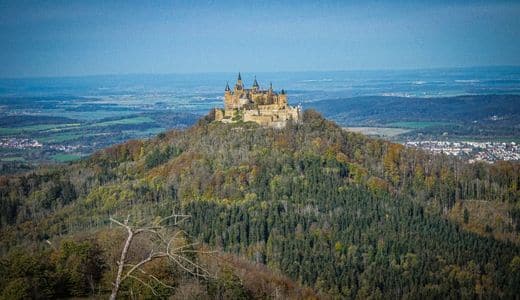
The Swabian Alb is an impressive low mountain range with unique karst landscapes, prehistoric sites and picturesque villages. The Swabian Jura, as the region is also known, stretches from Baden-Württemberg with its foothills all the way to Bavaria and Switzerland.
Highlights:
- Caves and Ice Age art: The Swabian Alb is famous for its numerous caves, including the Hohle Fels and Vogelherdhöhle caves, which are part of the UNESCO World Heritage Caves and Ice Age Art of the Swabian Alb and are home to some of the oldest works of art known to mankind. These caves not only offer exciting insights into prehistoric times, but also impressive geological formations.
- Hohenzollern Castle: The ancestral seat of the Hohenzollern family on the Zollerberg is one of the most striking landmarks of the Swabian Alb and the whole of Baden-Württemberg. A guided tour through the magnificently restored rooms offers deep insight into the history of the German nobility. You can find out why this castle is actually a palace in my article Castle or Palace: What are the Differences? The best photo spot to take a picture of Hohenzollern Castle is on the opposite Zeller Horn.
- Thermal baths and wellness: The Swabian Alb is also known for its healing thermal springs and wellness offers. Places such as Bad Urach and Bad Boll invite you to relax and enjoy their relaxing thermal baths and wellness oases.
Places of interest:
- Lichtenstein Castle: Inspired by Wilhelm Hauff's work "Lichtenstein", Wilhelm Count of Württemberg had the "fairytale castle of Württemberg" built high above the Echaz Valley in a historicist style. A truly romantic setting with breathtaking views!
- Urach Waterfall: As one of the highest waterfalls in Baden-Württemberg, the Urach waterfall offers a magnificent natural spectacle, especially after rainfall or during the snowmelt. Hiking trails around the waterfall are ideal for walks and more challenging hikes in the beautiful surroundings. The picturesque Hohenurach castle ruins is worth the climb, which is quite steep at the end.
- Blautopf: Germany's most impressive karst spring, known for its more or less intense sapphire blue water depending on the incidence of light, is located near Blaubeuren, right next to a picturesque historic hammer mill. The blue wonder is the setting for Eduard Mörike's romantic story of the beautiful Lau, but is also the entrance to one of the largest underground cave systems in Germany. You can easily walk around the Blautopf in 20 minutes, while more challenging hiking trails lead to ruins, rugged rocks, caves and viewpoints around Blaubeuren. In the immediate vicinity of the Blautopf is the interesting Blaubeuren Monastery.
Tips for your trip:
- Best time to travel: The Swabian Alb can be visited all year round, but offers the ideal conditions for outdoor activities in spring and autumn with its mild climate and colorful landscapes. In spring, 1.5 million fruit trees on the Albtrauf provide a Swabian hanami.
- Discover the Alb on foot or by bike: You can explore the unique landscape of the Swabian Alb on 90 certified hiking trails and 962 kilometers of ADFC-certified cycle paths.
- Culinary specialties: Enjoy regional delicacies such as Swabian Maultaschen, lentils with spaetzle, onion tart, Gaisburger Marsch or Swabian roast onion, which are offered in most restaurants, and a beer from Ehingen or Zwiefalten. As a Swabian, I could list many more delicacies here, but that would be going too far.
The Swabian Alb offers a tempting combination for anyone who wants to combine nature experiences with cultural and culinary discoveries. In my opinion, it is one of the most underrated regions in Germany. If you're not out and about at weekends or on public holidays, you can enjoy many a highlight without the crowds of tourists.
43. Swabian Danube Valley: Natural Wonders in Bavarian Swabia
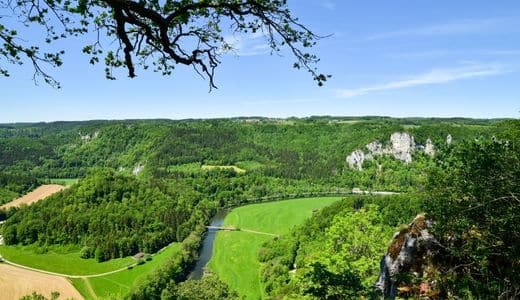
The Swabian Danube Valley between Ulm and Donauwörth awaits you in the southwest of Bavaria and the outskirts of Baden-Württemberg over a stretch of around 100 km with breathtaking river landscapes, medieval castles and a rich history that comes to life in the towns and villages along the river.
Highlights:
- Danube cycle path: One of the most popular cycle paths in Europe runs through the Swabian Danube Valley and offers cyclists the opportunity to explore the region at a relaxed pace. The route winds along the Danube through picturesque and spectacular landscapes, with a multitude of historical sights to visit.
- DonAUwald hiking trail: On this specially designed hiking trail along the Swabian Danube, you can experience the fascinating alluvial forest areas up close, which are known for their biodiversity and rare plant and animal species. Between Günzburg and Schwenningen, this flattest premium hiking trail in Germany, which runs in several stages through deciduous forests and lake landscapes along the mighty Danube, offers leisure hikers and families with children an impressive experience of nature.
- Canoe tours on the Danube: Experience the Swabian Danube Valley from a new perspective on a canoe tour on the Danube. On leisurely boat tours, you can enjoy the scenic beauty in peace and quiet while observing rare water birds.
Places of interest:
- Upper Danube Nature Park: The Danube Breakthrough between Tuttlingen and Sigmaringen, also known as the "Swabian Grand Canyon", is particularly around Beuron a breathtaking backdrop of steep limestone cliffs, between which the Danube winds its way. High trails take you to the most beautiful viewpoints on the steep Jura cliffs, such as the Knopfmacherfelsen, from where you can see the Danube valley at the Danube Breakthrough all the way to Beuron Abbey and Bronnen Castle from 800 meters above sea level.
- Beuron Monastery: Located in the heart of the Danube valley, the Benedictine monastery, founded in the 11th century as an Augustinian canonry, attracts visitors with its impressive architecture and spiritual atmosphere. The monastery is also a center of art and regularly offers guided tours and spiritual retreats.
- Ulm Minster: Ulm Minster, with the highest church tower in the world, is one of the most impressive Gothic cathedrals in Germany. A climb up the tower rewards you with a breathtaking view over the city, the Danube valley and the surrounding area.
Tips for your trip:
- Best time to travel: The Swabian Danube Valley is at its best in spring and fall. In spring, nature blossoms and the meadows and forests along the Danube are full of life. In autumn, the colorful deciduous forests interspersed with white limestone cliffs offer picturesque photo opportunities.
- Canoe and boat trips: Take the opportunity to explore the Danube by water. A canoe or boat trip offers a unique perspective of the landscape and is ideal for enjoying the tranquil beauty of the valley.
- Animal observations: The alluvial forests of the Swabian Danube Valley are unique habitats where you can observe animals that are rarely seen elsewhere, such as the beaver and bird species such as the Eurasian curlew, black-tailed godwit and blue rock thrush. In the fall, the Swabian Danube Valley is an important resting place for migratory birds - so pack your binoculars!
With its moors, lakes, rugged cliffs and the most beautiful alluvial landscapes in Germany, the Swabian Danube Valley offers you a wide range of experiences. If you are looking for peace and relaxation in nature and want to experience the regional culture, this is the place for you.
44. Lake Constance: A Jewel in the Heart of Europe
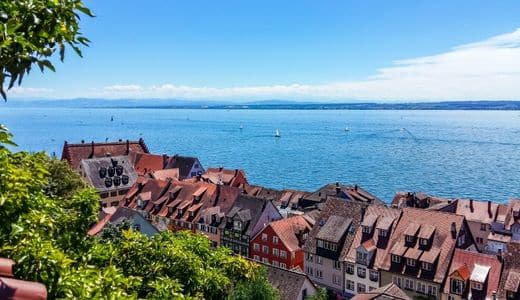
Lake Constance, nestled in a picturesque setting in the border triangle between Germany, Austria and Switzerland, is one of the largest and most beautiful lakes in Europe. This diverse region combines magnificent nature with a pleasant climate and cultural diversity, making it a popular destination for tourists from all over the world.
Highlights:
- Island of Mainau: The flower island of Mainau, a real garden paradise, enchants its visitors all year round: In spring with a sea of tulips on the spring avenue, in summer with an impressive 1,000 varieties of roses in the Italian rose garden by the castle, and in fall with the splendor of the dahlia garden. The butterfly house, arboretum and roof garden are further highlights.
- Monastic Island of Reichenau: The Reichenau is UNESCO World Heritage Site. and a historical jewel that reflects the religious and cultural significance of a large Benedictine monastery in the Middle Ages. Visitors can admire the three well-preserved Romanesque churches of St. George, St. Mary and St. Mark and St. Peter and Paul, which impress with their wall paintings and sacred treasures.
- Lake Constance cycle path: One of the most popular cycle routes in Europe, with a length of 260 kilometers, circles the entire Lake Constance. This route offers cyclists spectacular views of the lake and the Alps as well as many opportunities to explore charming villages, historic towns and picturesque landscapes.
Places of interest:
- Zeppelin Museum Friedrichshafen: This museum sheds light on the fascinating history of airship travel. The detailed 33-meter-long partial reconstruction of LZ 129 Hindenburg in particular attracts technology enthusiasts. The museum also houses an important art collection with works by Otto Dix, Marta Hoepffner and Andreas Feininger.
- Pile dwellings Unteruhldingen: As part of the UNESCO World Heritage Site Prehistoric Pile Dwellings around the Alps these reconstructed pile dwellings provide an insight into the life of people on Lake Constance during the Stone and Bronze Ages.
- Meersburg: The Meersburg, Germany's oldest inhabited castle, which is the namesake of this picturesque town. The castle, which is over 1,000 years old, has never been destroyed and can be explored on a tour that also takes you through the rooms where the famous German poet Annette von Droste-Hülshoff lived and worked for some time, and where she died on May 24, 1848. Meersburg's historic old town enchants visitors with its romantic alleyways and spectacular views of the lake.
Tips for your trip:
- Best time to travel: Summer is ideal for water sports and visiting numerous festivals and events on Lake Constance. Spring and fall are ideal for exploring with milder temperatures and less hustle and bustle.
- Culinary delights: Lake Constance is famous for its fish specialties, especially whitefish. You should also try the regional wines and the popular apple pie.
- Events: Visit the Bregenz Festival, Constance Lake Night Festival or one of the many wine and fishing festivals that offer insights into the regional culture and way of life.
- Trips to neighboring countries: The 1064 m high Pfänder on the Austrian side of Lake Constance offers a magnificent view of the lake and the surrounding Alpine peaks. The biggest Swiss attraction near Lake Constance is the Rhine Falls near Schaffhausen.
Lake Constance impresses with its unique blend of spectacular nature, rich history and vibrant culture. The region offers countless opportunities for relaxation and discovery and remains an unforgettable destination for every visitor.
45. The Allgäu: Between Alpine Peaks and Royal Castles
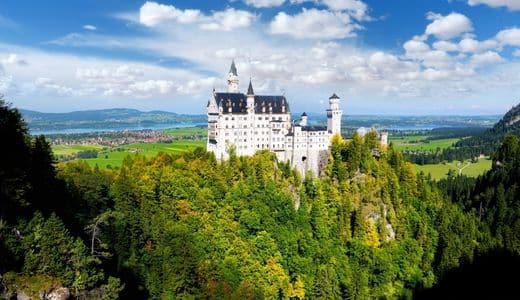
The Allgäu, one of the most picturesque and diverse regions in southern Germany, stretches as far as the Alps and scores with its impressive landscapes, famous royal castles and excellent winter sports facilities. This region offers a perfect combination of nature experiences, cultural heritage and opportunities for active recreation.
Highlights:
- Königswinkel: The Königswinkel around Füssen is for me the most picturesque region in the Allgäu and is characterized by the famous royal palaces such as Neuschwanstein Castle, built by King Ludwig II, and Hohenschwangau Castle, which blend harmoniously into the breathtaking Alpine landscape. The area also includes idyllic lakes such as the Forggensee, the Hopfensee and the Alpsee, which invite you to enjoy relaxing activities and wonderful hikes. Tegelberg mountain offers a wonderful view of the Königswinkel.
- Hiking and mountaineering: The Allgäu is a paradise for hikers and mountaineers with a multitude of trails that lead through breathtaking Alpine landscapes. The hiking trails around Grünten, Nebelhorn & Co. offer spectacular views and wonderful nature experiences.
- Nagelfluhkette: This impressive mountain range in the Allgäu, consisting of several peaks such as Hochgrat, Rindalphorn and Stuiben, offers spectacular panoramic views and is a popular destination for mountaineers and hikers. The unique geological composition of the Nagelfluh, a conglomerate rock, characterizes the landscape.
Places of interest:
- Oberstdorf: A well-known winter sports resort that also offers numerous summer activities such as hiking, climbing and paragliding. Oberstdorf is also known for its annual ski jumping competitions. The Nebelhorn is snow-sure until the beginning of May. A hike through the Breitachklamm gorge between Oberstdorf and Kleinwalsertal, the deepest rocky gorge in Central Europe, is a highlight of any visit to the Allgäu. Hiking boots are a must!
- Füssen: Although Füssen is mainly associated with the nearby Neuschwanstein Castle, the town itself is definitely worth a visit with its picturesque old town, the Hohes Schloss and the Museum of the Town of Füssen.
- Kempten: As one of the oldest cities in Germany, Kempten offers a fascinating mix of historical significance and modern flair. The Cambodunum Archaeological Park brings Kempten's Roman past to life. Visitors can explore the magnificent Kempten Residential Palace and St. Lawrence Basilica, which impresses with its magnificent baroque architecture. The lively city center with its numerous stores, cafés and markets invites you to stroll around and linger.
Tips for your trip:
- Best time to travel: The Allgäu is an attractive destination all year round. While the winter months are perfect for skiing and snowboarding, spring, summer and fall offer ideal conditions for hiking, cycling and other outdoor adventures.
- Culinary delights: In addition to the famous Allgäu cheese, you should also try other regional specialties such as Kässpatzen, beef goulash and Apfelküchle.
- Hiking equipment: Hiking boots, functional clothing and a daypack are among the basics when you're on vacation in the Allgäu. I myself never go hiking without walking poles - they make ascents and descents so much easier.
- Events: The Allgäu is known for its lively folk festivals, including Viehscheid in September, when the alpine farmers drive their herds from the summer pastures into the valley, which is celebrated with a great spectacle. Another typical Allgäu festival is the Funkenfeuer (spark fire) on the first Sunday after Ash Wednesday.
The Allgäu has a unique charm that captures the hearts of nature lovers, culture enthusiasts and active vacationers alike. With its breathtaking Alpine scenery, legendary royal castles and rich tradition, the region offers incomparable experiences.
46. Blaues Land (Blue Land): Artistic Inspiration between Lakes and Mountains
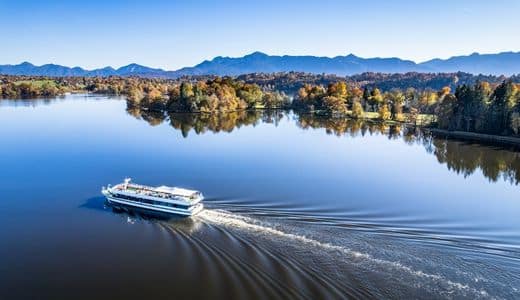
The artist group Der Blaue Reiter (The Blue Rider) around Wassily Kandinsky, Gabriele Münter, August Macke and Franz Marc gave the Staffelsee region its name, which refers to the unique blue shimmer that covers its landscape in certain light conditions. Museums, wetlands, moors, forests and the fantastic view of the Wetterstein and Zugspitze as well as the Ammergau Alps attract art lovers and those seeking relaxation to this idyllic region.
Highlights:
- Staffelsee: The Staffelsee is a center of recreation and a wonderful place for water sports, relaxed boat trips or simply to enjoy the peaceful atmosphere by the water. The surrounding hiking trails offer great views of the Alps and invite you to take a walk in nature.
- Münter House in Murnau: Visit the "Russenhaus" (referring to Kandinsky's Russian origins), where Gabriele Münter and Wassily Kandinsky lived and worked together between 1909 and 1914. Now a museum, it displays many of their works and preserves the atmosphere that inspired these artists to create some of their most important works.
- Hike through the Murnauer Moos: The with 32 km2 You can experience the largest contiguous moorland area in Central Europe on a 12 km hike or a guided moorland tour.
Places of interest:
- Murnauer Schlossmuseum (Murnau Castle Museum): The museum houses an impressive collection of works by the Expressionists, including Kandinsky, Münter and other members of the Blue Rider. It also offers regular special exhibitions on local art and cultural history.
- Franz Marc Museum in Kochel am See: In 1914, Franz Marc bought a villa in Ried, which belonged to Kochel am See. The planned extension to his studio never materialized, as Marc was called up immediately after the outbreak of the First World War and fell in Braquis near Verdun on March 4, 1916. The museum exhibits an extensive collection of Franz Marc's expressionist paintings and works by his artist friends such as Paul Klee and the members of the Blue Rider.
- Walchensee: Just a stone's throw away from Kochelsee, this blue-green Alpine lake with its panorama of the Karwendel and Wetterstein mountains is a popular destination for water sports enthusiasts, hikers and nature lovers. Due to the clear underwater visibility and some interesting wrecks (even three airplane wrecks), the Walchensee is also interesting for divers.
Tips for your trip:
- Best time to travel: The Blue Land is attractive all year round. Summer offers ideal conditions for hiking and water sports on the Staffelsee, while autumn is particularly picturesque with its vibrant colors.
- Culinary delights: Enjoy local specialties such as Bavarian "Brotzeit" (brown bread and pretzels with cold meat and cheese, which Bavarians often have for dinner), fresh fish from the lakes and traditional pastries in the cosy cafés and restaurants.
- Cultural events: Take advantage of the diverse cultural offerings such as exhibitions, concerts and festivals that celebrate the region's artistic heritage.
The Blue Land is an oasis of inspiration and tranquillity that appeals to art lovers and nature enthusiasts alike. With the Ammergau Alps region, there are further highlights in the immediate vicinity.
47. Ammergau Alps: Between Majestic Peaks and Cultural Treasures
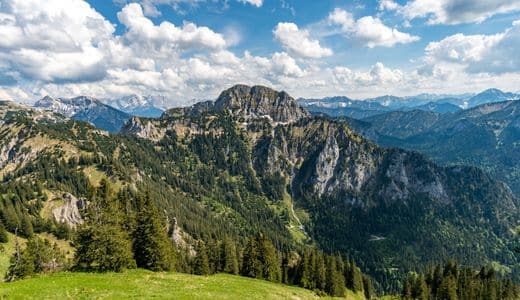
The Ammergau Alps, known for their spectacular natural scenery and deep-rooted Bavarian traditions, offer an idyllic backdrop for those seeking relaxation and culture lovers. This area between Bad Bayersoien in the north and the Graswang Valley in the southwest attracts visitors from all over the world with its majestic peaks, clear lakes and picturesque villages.
Highlights:
- Linderhof Palace:: Linderhof Palace, built by order of King Ludwig II from 1870 to 1886, is proposed for the UNESCO World Heritage List together with the other palaces of King Ludwig II. The smallest of Ludwig's palaces is famous for its magnificent interior and impressive gardens with the Venus Grotto, which was inspired by Richard Wagner's Tannhäuser .
- Hiking and winter sports: The region offers excellent opportunities for outdoor activities. In summer, there are numerous hiking trails, while in winter the ski areas with excellent pistes and cross-country ski trails are a delight.
- White water rafting: The Ammer, which meanders through the picturesque landscapes of the Ammergau Alps, offers adrenaline junkies exciting opportunities for white water rafting. Guided tours can be booked with professional providers, guaranteeing safety and an intense experience in the wild nature.
- Plansee and Heiterwanger See: A beautiful excursion across the border to Austria leads to two of the most beautiful lakes in Tyrol, which are carved like fjords into the impressive mountain scenery of the Ammergau Alps. They are popular destinations for water sports such as sailing, diving and swimming. The lakes are also excellent starting points for hikes in the surrounding mountains, with well-marked paths leading through picturesque landscapes.
Places of interest:
- Wieskirche: This magnificent rococo church, which is a UNESCO World Heritage Site. is picturesquely situated in the countryside near Steingaden. With its ornate frescoes and detailed stucco, it is a unique 18th century masterpiece and one of the most beautiful churches in Germany.
- Lüftlmalerei and Herrgottsschnitzer in Oberammergau: Famous for its elaborate and colorful house paintings as well as the traditional local wood carvers, Oberammergau offers a very special Bavarian experience. The village is also famous for the Passion Plays which only take place every 10 years and attract thousands of spectators.
- Ettal Monastery: The Benedictine abbey Kloster Ettal was founded in 1330 and is an important spiritual and cultural center of the region. It impresses with a baroque four-winged complex and the monastery church of the Assumption of the Virgin Mary. The monks have been producing traditional monastery beer in the adjoining brewery since 1609.
Tips for your trip:
- Best time to travel: The Ammergau Alps are an attractive destination all year round. Summer offers perfect conditions for hiking, while winter is ideal for skiing and other snow sports.
- Culinary delights in Ettal: In two buildings of the show dairy Ettal you can see how 3,000 liters of milk are processed into cheese every day and, of course, taste it. On a guided tour through the Ettal Monastery Brewery you will learn a lot about the monks' brewing tradition.
- Events: In addition to the Passion Plays, numerous local festivals and markets take place in the region, offering insights into traditional crafts and customs.
Although the Ammergau Alps boast some of the biggest tourist attractions in Germany, the region is sparsely populated, meaning that there are also plenty of quiet oases and secluded hiking trails to be found here. The combination of cultural highlights and the majestic landscape makes the region a dream destination.
48. Wetterstein Mountains: Summit Dreams and Deep Gorges

The Wetterstein mountain range, one of the most impressive mountain ranges in the Eastern Alps, lies on the border between Germany and Austria and offers a spectacular backdrop for outdoor enthusiasts and nature lovers. With the Zugspitze as the highest point in Germany, this mountain range is a paradise for hikers, climbers and winter sports enthusiasts.
Highlights:
- Zugspitze: Climb Germany's highest peak, the Zugspitze, either via challenging climbing routes or in the comfort of the Zugspitze cable car. The breathtaking view from the viewing platform offers a 360-degree view of countless Alpine peaks in Germany, Austria, Switzerland and Italy.
- Partnachklamm: This spectacular gorge near Garmisch-Partenkirchen is known for its wild waterfalls, rapids and dramatic crevices. A network of secured paths and bridges allows visitors to experience the raw beauty of this force of nature up close.
- Alpine skiing and snowboarding: The Wetterstein mountains are a hotspot for winter sports with first-class ski resorts such as Garmisch-Classic and Zugspitzplatt. These areas offer excellent pistes, modern lifts and are a mecca for skiers and snowboarders.
Places of interest:
- Eibsee: Situated below the Zugspitze, the crystal-clear Eibsee with its stunning location and clear, shimmering green water offers ideal conditions for canoeing, swimming and relaxing walks along the shore. The 7.5 km long Eibsee circular trail, one of the most beautiful walking trails in Bavaria, offers fantastic views of the lake and the Zugspitze.
- Mittenwald: Known as the "village of violin makers", Germany's highest climatic health resort enchants visitors with its picturesque location between the Wetterstein, Kranzberg and Karwendel mountains. The colorful houses of the village are known for their magnificent Lüftlmalereien (paintings on the house facades), which depict traditional Bavarian motifs. Mittenwald is an ideal starting point for great hikes - take the chairlift up Mittenwald's local mountain, the Hoher Kranzberg, or the cable car to the Karwendel mountains, where the "Bergwelt Karwendel" information center at 2,244 m above sea level offers breathtaking views of the Zugspitze and the Isar Valley.
- Alpspitze: The 2,628 m high mountain with its striking pyramid-shaped peak offers some of the best climbing routes and hiking trails in the Wetterstein mountains. From the intersecting footbridges of the Alpspix viewing platform on the mountain, you have a breathtaking view of the Alpine panorama and down into the Höllental valley.
Tips for your trip:
- Best time to travel: The Wetterstein mountains are an attractive destination all year round. In summer, it is ideal for hiking, mountaineering and climbing, while winter is perfect for alpine skiing.
- Culinary delights: Enjoy traditional Bavarian and Tyrolean specialties such as Kaiserschmarrn, dumplings and game dishes prepared with regional products in the numerous mountain huts.
- Equipment: Make sure you have the right equipment for your activities. Good hiking boots, weatherproof clothing and possibly climbing equipment are essential for mountain tours.
The Wetterstein mountains are a stronghold for alpinists and nature lovers seeking the challenge and beauty of the mountains. With its diverse leisure activities, breathtaking landscapes and the warm hospitality of the locals, the mountains offer unforgettable experiences for every visitor.
49. Fünfseenland (Five Lakes Land): Natural Idyll and Relaxation Southwest of Munich
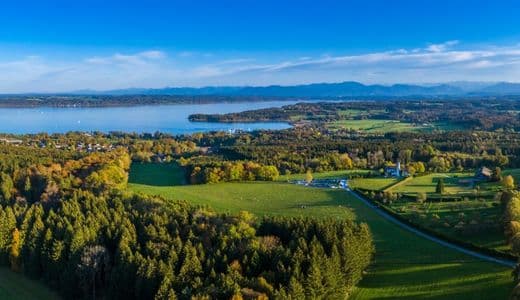
The Fünfseenland, a charming region southwest of Munich, includes the Starnberger See, Ammersee, Wörthsee, Pilsensee and Weßlinger See lakes. This area is known for its breathtaking nature, diverse recreational opportunities and historical significance, which attracts visitors from near and far.
Highlights:
- Lake Starnberg: Bavaria's second largest lake offers ideal conditions for sailing and boat trips. A boat trip on the lake offers wonderful views of the surrounding mountains and the magnificent villas along the shore. The Votive chapel in Berg and a wooden cross in the lake commemorate King Ludwig II, who died in Lake Starnberg in 1886 under unclear circumstances.
- Ammersee: The good wind conditions on the Ammersee make it a perfect sailing and surfing area. Numerous cycling and hiking trails around the lake invite you to explore the picturesque landscape and pretty villages. The most popular excursion destination on the Ammersee is Andechs Monastery, whose main attractions are the baroque pilgrimage church with impressive frescoes by Johann Baptist Zimmermann and the famous traditional monastery beers.
- Hiking and cycling tours: The region offers an excellent network of hiking and cycling trails that lead through picturesque landscapes and along the shores of the lakes. Especially the Ammer-Amper cycle path is popular with cyclists. The Ilkahöhe above Tutzing is a beautiful hiking destination and offers a breathtaking panoramic view of Lake Starnberg and the Alps.
Places of interest:
- Buchheim Museum on Lake Starnberg: This museum in Bernried is dedicated to the works of expressionist artists such as Emil Nolde, Ernst Ludwig Kirchner and Max Pechstein, as well as ethnological objects and folk art. It is based on the collection of the famous collector and artist Lothar-Günther Buchheim.
- Rose Island in Lake Starnberg: The small island - the only one in Lake Starnberg - is known for its beautiful rose gardens and the historic villa that once served as a retreat for King Ludwig II. But it is also archaeologically significant - it is one of the three Bavarian pile-dwelling settlements that are part of the UNESCO World Heritage Prehistoric Pile Dwellings around the Alps .
- Marienmünster Dießen on Ammersee lake: The former collegiate church of the Augustinian canons of Dießen was built by the important master builder Johann Michael Fischer and is a masterpiece of Bavarian rococo with its magnificent façade and richly decorated interior. The stucco work by the Feichtmayr brothers and the altarpieces by the Italian artists Tiepolo and Pittoni are well worth seeing.
Tips for your trip:
- Best time to travel: The Fünfseenland region is particularly inviting in summer for swimming, hiking and cycling. But beware: as the Fünfseenland is a local recreation area for Munich and Augsburg residents, there is a mass invasion of locals in lidos and beer gardens on nice summer weekends and during the vacations. Better to come in the low season or during the week. From Munich, the main towns on the lakes are easy to reach by S-Bahn or train.
- Culinary delights: Fresh fish, traditional Bavarian cuisine and the Bavarian way of life can be found in the numerous inns and beer gardens around the lakes.
- Royal Highnesses: Royalists can follow in the footsteps of King Ludwig II and his grand cousin Sisi, later Empress Elisabeth of Austria, to their heart's content in this region.
- Events: A discerning clientele of well-heeled residents ensures that festivals, art exhibitions and classical concerts of a high standard are on offer all year round.
The Fünfseenland region promises relaxation and enjoyment in one of Germany's most picturesque regions with great water sports, cultural treasures and a wide range of restaurants - but at a high price.
50. Tegernsee Valley: Recreation and Culture in the Heart of Bavaria
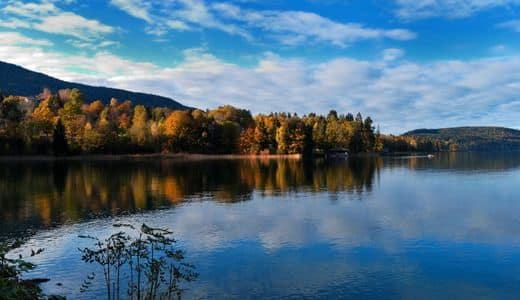
The Tegernsee Valley, known for its idyllic landscape and a centuries-old retreat for celebrities and aesthetes, is located around 50 km south of Munich in the Bavarian Alps. At the weekends, many ordinary people seeking relaxation mingle with the sophisticated residents.
Highlights:
- Tegernsee: The crystal-clear Tegernsee is the heart of the region and offers numerous water sports such as sailing, rowing and swimming. The lakeside promenade is ideal for leisurely walks with breathtaking views of the Alps and invites you to linger in the cafés and restaurants.
- Wallberg: You can reach the Tegernsee Valley's local mountain on foot (medium-difficulty hike) or with the Wallbergbahn cable car in Rottach-Egern, which offers an impressive view over the lake and the surrounding mountains. The Wallberg is also a popular destination for paragliders.
- Hike to the Tegernsee hut: One of the most popular hikes in the Tegernsee valley for experienced hikers (small via ferrata and paths well secured with steel ropes) leads to the picturesquely situated Tegernseer Hütte. The hut is located between the peaks of the Roßstein and Buchstein and offers breathtaking views of the Tegernsee valley and the surrounding Alpine peaks. The ascent to the hut requires a head for heights and sure-footedness. The route rewards you with spectacular panoramic views and the opportunity to stop off at a traditional Alpine hut.
Places of interest:
- Bad Wiessee: The only spa on Lake Tegernsee, known for its sulphur springs, is beautifully situated on the western shore of the lake. With its beautiful lakeside promenade, first-class spa facilities and one of the most beautiful golf courses in Germany, Bad Wiessee invites you to spend relaxing days in picturesque surroundings. A beautiful hike along the Prinzenruhweg leads through the Zeiselbach valley to the Prinzenruh viewpoint with a fantastic view over the lake.
- Tegernsee Castle: The former Benedictine monastery, now a private castle complex, was founded in 746. In the Middle Ages, the monastery was famous for its extensive library and the glass workshop where painted church windows were made. The castle is home to a brewery, a fishery, a grammar school and two restaurants. The baroque monastery church of St. Quirin impresses with its rich furnishings and ceiling frescoes by Hans Georg Asam, the father of the famous Asam brothers.
- Olaf Gulbransson Museum: The underground museum honors the life and work of the Norwegian artist and caricaturist Olaf Gulbransson. Among other things, he illustrated Ludwig Thomas' "Lausbubengeschichten" and worked together with Thoma, who, like Gulbransson, lived at Tegernsee, for the German satirical magazine "Simplicissimus".
- Natural cheese dairy TegernseerLand: This cheese dairy produces handmade cheese from regional milk. Visitors can watch the production process on public tours (by appointment only) and buy the fresh products directly on site.
Tips for your trip:
- Best time to travel: The Tegernsee Valley is attractive all year round - ideal for water and mountain sports in summer and for cross-country skiing and leisurely walks in the snow in winter. If you can, avoid weekends, public holidays and vacation times.
- The art of brewing and gastronomy: The Tegernsee valley is known for its brewing tradition. In the Herzoglich Bayerisches Brauhaus Tegernsee, founded in the 17th century, you can enjoy one of the five types of beer brewed in-house in the Herzogliches Braustüberl or the Schlosswirtschaft with its fantastic terrace, accompanied by Bavarian delicacies or Asian dishes. There are countless other opportunities to sample regional cuisine in traditional inns around the lake.
- Activities for families: In addition to sporting activities, there are many opportunities for families to explore nature in the Tegernsee Valley, including themed hiking trails and nature trails.
The Tegernsee Valley offers natural beauty, leisure activities and the Bavarian way of life for every taste.
51. Lake Chiemsee: Royal Dreams and Natural Idyll
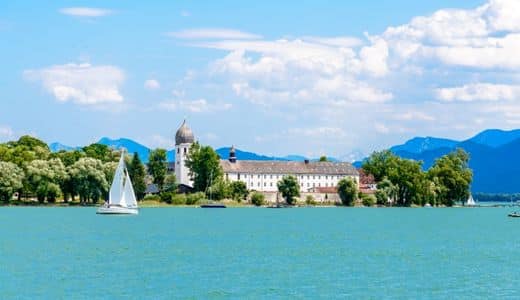
Chiemsee, often referred to as the "Bavarian Sea", is the largest lake in Bavaria and the third largest lake in Germany. Against the picturesque backdrop of the Chiemgau mountains, the region around the lake offers a perfect blend of beautiful nature, historical sights and a variety of leisure activities, making it a popular destination for visitors from all over the world.
Highlights:
- Herrenchiemsee: The island of Herrenchiemsee is home to the magnificent palace of the same name, which was built by King Ludwig II in the style of Versailles. With its extensive gardens and magnificent rooms, it offers an insight into the extravagant life of the fairytale king.
- Fraueninsel: The smaller of the two inhabited islands in Lake Chiemsee, Fraueninsel, is known for its old Benedictine monastery and picturesque fishermen's houses. The island offers a peaceful and relaxed atmosphere and is ideal for a leisurely stroll along the lakeshore.
- Sailing and water sports: Lake Chiemsee is a paradise for water sports enthusiasts. With its ideal wind conditions, it is popular with sailors, windsurfers and kitesurfers.
Places of interest:
- Kampenwand: For hiking and climbing enthusiasts, the nearby Kampenwand offers fantastic routes and spectacular views of Lake Chiemsee and the surrounding Alps. The cable car makes the ascent easier and also allows less experienced hikers to experience the summit.
- Amerang Castle: This historic castle near Lake Chiemsee is home to an interesting car museum and an agricultural museum. The castle also regularly hosts classical concerts and other cultural events.
- Chiemsee Uferweg (Chiemsee lakeside path): This easily accessible trail, which leads around Lake Chiemsee, offers hikers and cyclists wonderful views and cozy resting places.
Tips for your trip:
- Best time to travel: Lake Chiemsee is an attractive destination all year round, with the summer months from June to August being particularly popular for water sports and hiking. Winter attracts visitors with a quieter atmosphere and an idyllic snow-covered Alpine landscape.
- Culinary delights: The region around Lake Chiemsee is known for its fish specialties, especially whitefish and eel from the lake. The local inns also offer traditional Bavarian cuisine that should not be missed.
- Events: Visit one of the top-class concerts at the Herrenchiemsee Festival, the midsummer bonfire on the Kampenwand or the Viehscheid (cattle drive) in Sachrang. In the villages around Lake Chiemsee, there are cultural events for every taste all year round against a magnificent backdrop.
Whether you want to follow in the footsteps of Ludwig II, relax by the water or explore the mountains on boat, hiking and climbing tours - Lake Chiemsee offers something for everyone and leaves you with unforgettable impressions.
52. Alpine Paradise Berchtesgadener Land: A Journey through Natural Wonders and History
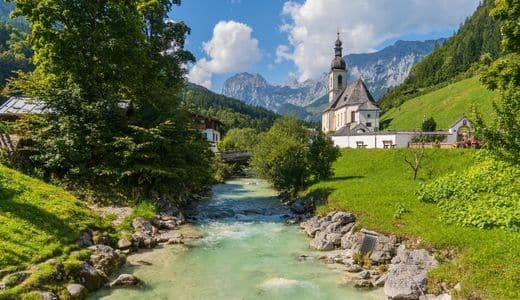
The Berchtesgadener Landnestled in the breathtaking Berchtesgaden Alps, is a region that impresses with its spectacular natural beauty and deeply rooted traditions. Hardly any other region in Germany is better developed for tourism and offers more diverse experiences for every taste than this one.
Highlights:
- Lake KönigsseeFamous for its crystal-clear water and the surrounding steep rock faces, Lake Königssee offers unforgettable experiences and unique photo opportunities with the famous Echo Wall and the picturesque St. Bartholomä Chapel. As it is surrounded by steep cliffs, the lake can only be visited by boat. Take the cable car to the Jenner summit and enjoy the magnificent view of Lake Königssee from above! During certain promotional periods, discounted combi-tickets for the boat trip on the lake and the cable car ride up the Jenner are offered.
- Zauberwald (Magic Forest) at Lake Hintersee: The Zauberwald near Ramsau, a mystical forest full of moss-covered stones and old trees, leads to the picturesque Hintersee. This idyllic body of water, framed by the majestic Alps, offers spectacular photo opportunities and is a paradise for nature lovers.
- Wimbachklamm near Ramsau: The wild and romantic gorge in Berchtesgaden National Park impresses with its narrow, steep rock faces, between which the turquoise-colored water makes its way over the rock steps and through the gorge. The moss-covered rock face opposite the wooden footbridge is particularly impressive, with the water running down it, giving the gorge a mystical atmosphere. The path through the gorge is only about 200 m long. From the exit, it takes about 20 minutes down a steep path back to the parking lot at the Wimbach bridge.
Places of interest:
- Mount ObersalzbergOnce the site of Hitler's Berghof, Obersalzberg is now a place of historical debate and education with the Obersalzberg Documentation Center. The new permanent exhibition "Idyll and Crime" was opened in May 2024. Public guided tours of the permanent exhibition and the bunker complex are offered every Wednesday and Saturday at 11 a.m.
Those who still want to visit Kehlsteinhaus, either have to hike (approx. 3 hours one way) or take the paid bus (departure next to the Obersalzberg documentation center). Although Hitler was hardly ever there due to his fear of heights, it is mainly American tourists who are drawn to the "Eagle's Nest", who have to fork out a hefty €31.90 per person, including a dizzying bus ride and ascent with the Eagle's Nest lift. - Maria Gern pilgrimage church: This picturesque pilgrimage church with its location against the impressive backdrop of Watzmann in the south and Untersberg in the north is a spiritual and visual highlight in the Berchtesgadener Land region. Famous for its baroque architecture, the lovingly designed frescoes, putti and stucco work as well as the miraculous image by Wolfgang Hueber in the high altar, the church attracts art lovers as well as photographers and pilgrims.
- Berchtesgaden Salt MineA visit to the salt mine provides fascinating insights into centuries of salt mining, including a ride on the visitor train, a slide down the old wooden chutes and a boat ride across the underground salt lake. An experience for the whole family!
Tips for your trip:
- Best time to travel: Berchtesgadener Land has a lot to offer all year round. Summer is ideal for hiking, climbing, paragliding and water sports, while in winter the perfect infrastructure ensures unlimited snow fun.
- Regional cuisine: Enjoy regional specialties such as roast pork with dark beer sauce and bread dumplings, smoked trout fillets or home-baked apple strudel, which are offered in the many mountain huts and inns.
- Festivals and events: Bavarian customs and traditions are alive and well in Berchtesgadener Land. Take the opportunity to experience one of the many regional events such as the maypole raising (1st May), the Viehscheid in Schönau (September) or the Berchtesgaden Advent (December).
Last but not least - the Berchtesgadener Land region is one of the best that Germany has to offer. The region impresses every visitor with its breathtaking scenery and offers a wide range of sights and opportunities to experience the magnificent nature.
Continue reading
I have put together my tips for The Most Beautiful Cities in Germany for you in a separate article.
If you feel like going on a road trip in Germany while browsing through this article, you can find inspiration for beautiful routes in my article Road Trip Germany - The Most Beautiful Routes with Highlights and Map.
A list of over 100 great travel destinations in Germany - sorted by federal state - for an initial overview can be found in the article Destination Germany - The Ultimate List of the 100+ Most Beautiful Places.

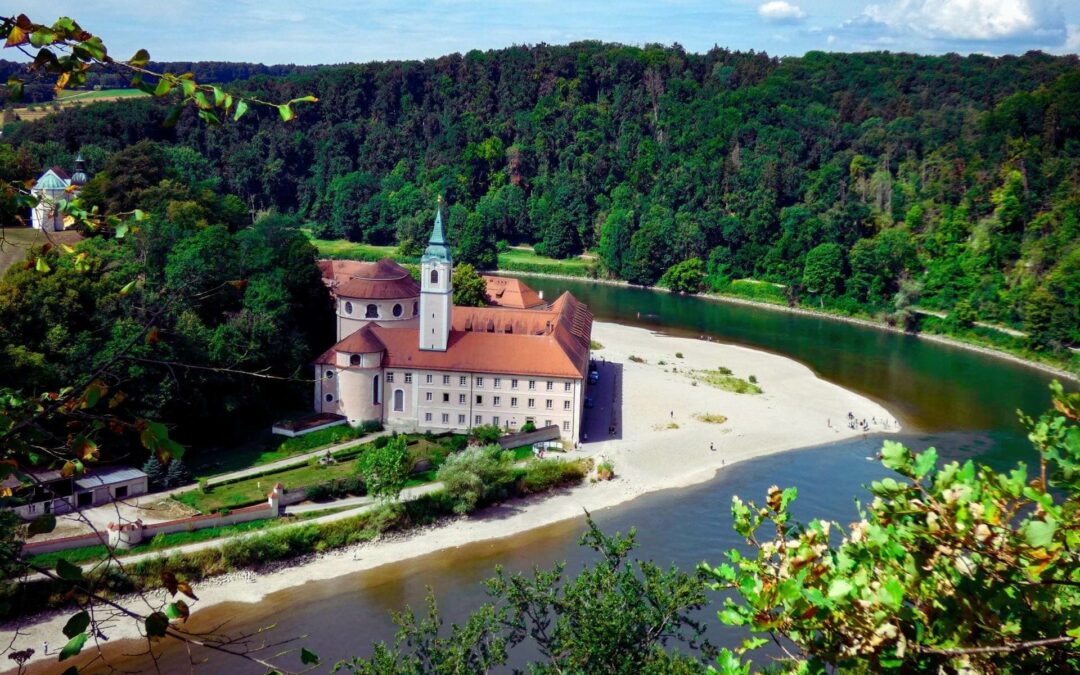
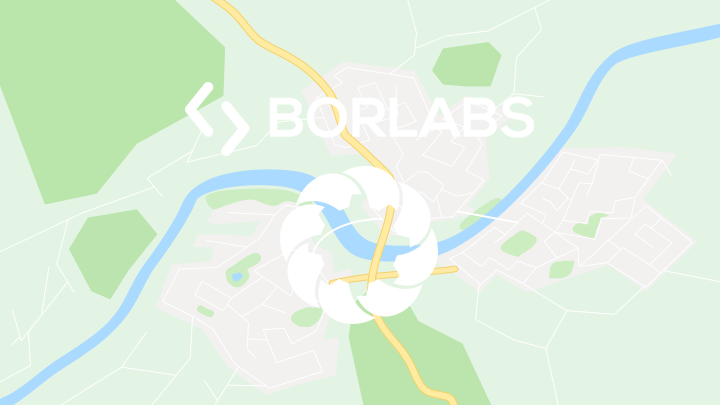
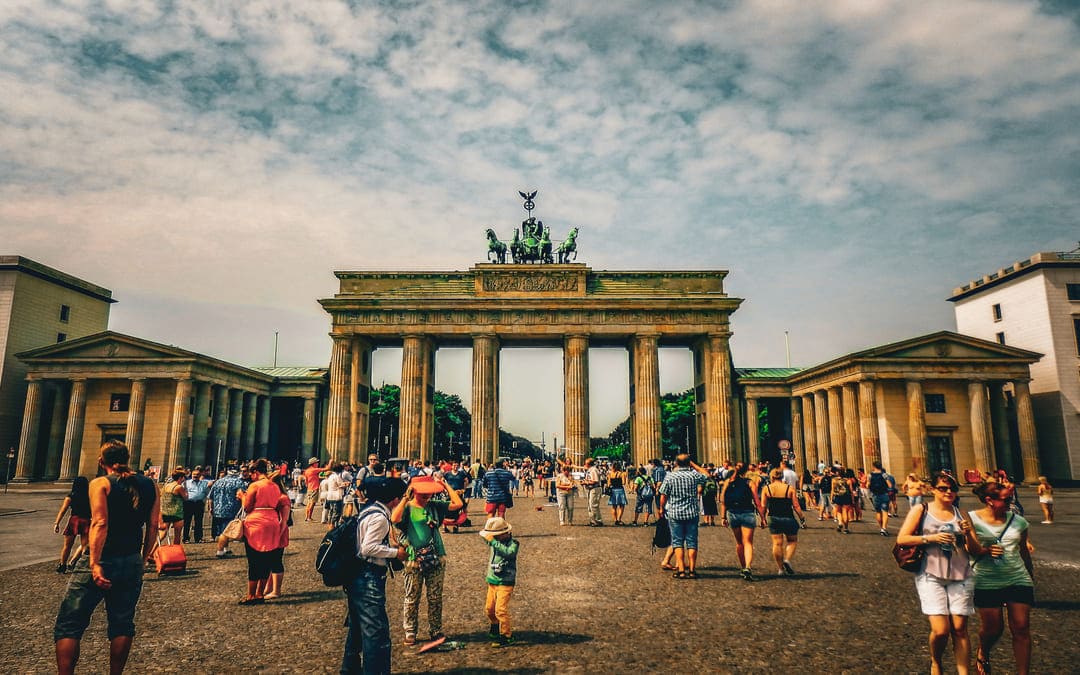
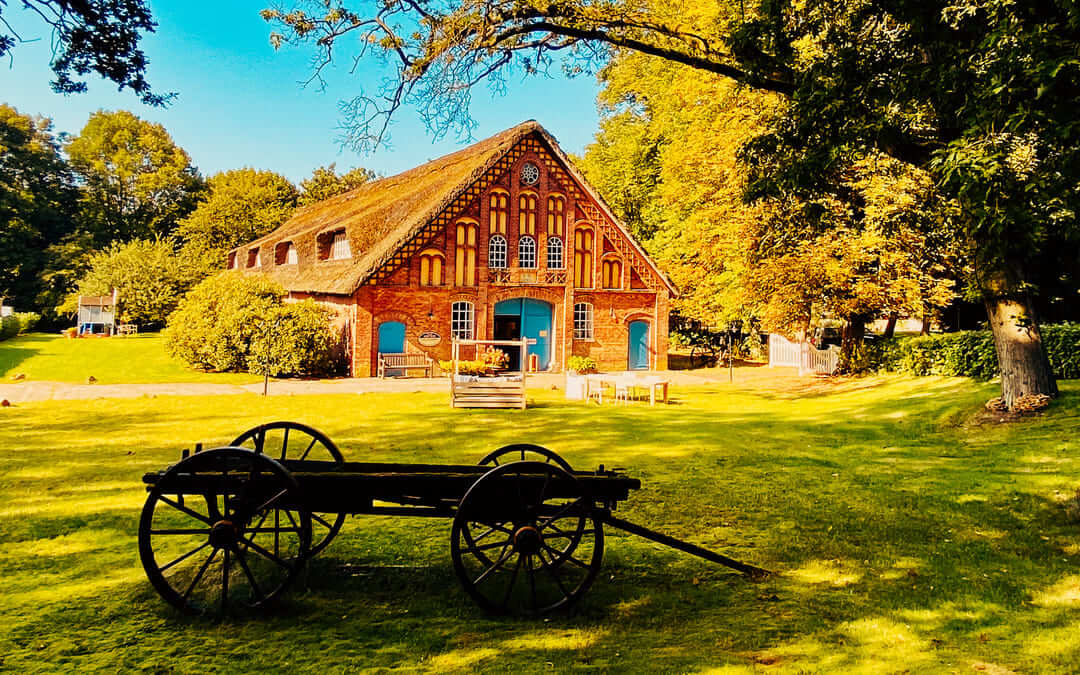

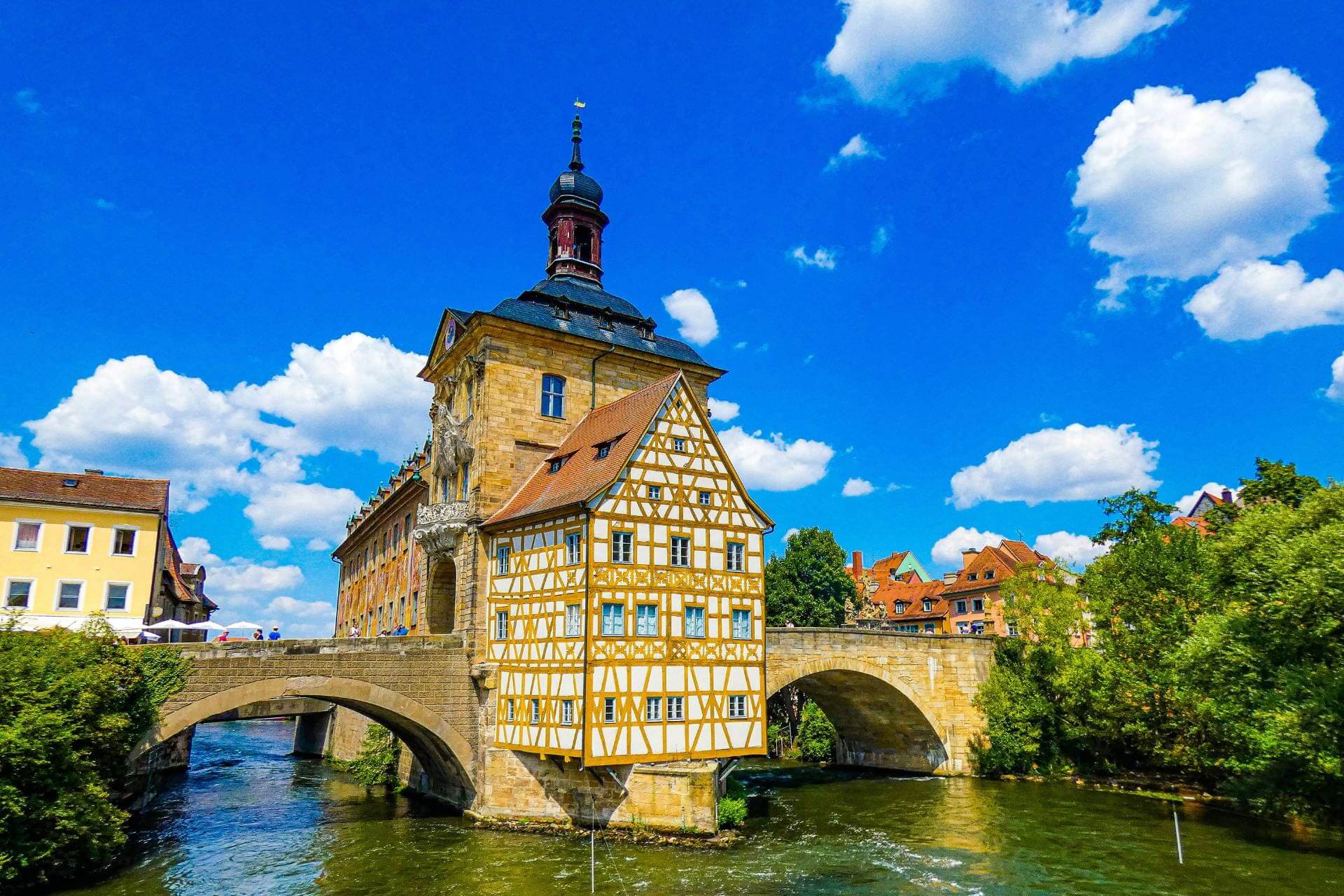

Thank you very much for your efforts and tips! We are also staying in Germany this year and will most likely be going to Heligoland. It's not too far away from us and we can easily get there by car and take our dog with us.
Dear Anna,
Thank you very much for your kind comment. I'd also like to go to Heligoland again - I've only been there on a day trip so far, but I'd like to get to know it better. I wish you lots of fun and great experiences!
Many greetings,
Angelika
Dear Astrid,
It's called "To Want" and not "Must Do" 😅. Fortunately!
Have a nice weekend!
Cheers,
Angelika